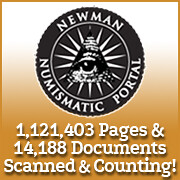
About UsThe Numismatic Bibliomania Society is a non-profit organization devoted to the study and enjoyment of numismatic literature. For more information please see our web site at coinbooks.org SubscriptionsThose wishing to become new E-Sylum subscribers (or wishing to Unsubscribe) can go to the following web page link MembershipThere is a membership application available on the web site Membership Application To join, print the application and return it with your check to the address printed on the application. Print/Digital membership is $40 to addresses in the U.S., and $60 elsewhere. A digital-only membership is available for $25. For those without web access, write to: Terry White, Treasurer
AsylumFor Asylum mailing address changes and other membership questions, contact Terry at this email address: terrywhite5475@yahoo.com SubmissionsTo submit items for publication in The E-Sylum, just Reply to this message, or write to the Editor at this address: whomren@gmail.com BUY THE BOOK BEFORE THE COINSale Calendar
|
- WAYNE'S WORDS: THE E-SYLUM JUNE 21, 2017
- SHARE YOUR COLLECTING ORIGIN STORY
- NEW BOOK: FORGOTTEN COLORADO SILVER
- NEW BOOK: GOLD: EVERYTHING YOU NEED, 2ND ED.
- NEW BOOK: LE FRANC POCHE
- NEW BOOK: ONE COLLECTOR...ONE BANKNOTE
- NEW BOOK: QUEBEC DAIRY TOKENS, 3RD EDITION
- THE NEWMAN NUMISMATIC PORTAL
- NOTES FROM E-SYLUM READERS: JUNE 18, 2017
- STILL MORE ON 'ABER NIT'
- MORE ON THE NEW DEPARTURE BELL COMPANY 'TOKEN'
- A “RED BOOK” FOR TOKENS AND MEDALS?
- VOCABULARY TERM: INSERT DIE
- COLIN EDWARD KING (1862-1921)
- QUERY: CANADIAN JESUIT INDIAN PEACE MEDAL?
- QUERY: LUCIEN COUDRAY’S ORPHEUS PLAQUE
- PARMELEE BIRCH CENT REDISCOVERED
- SELECTIONS FROM STACK'S BOWERS JUNE 2017 SALES
- NUMISMATIC NUGGETS: JUNE 18, 2017
- WAYNE'S NUMISMATIC DIARY: JUNE 18, 2017
- THE GOLD HOARD OF LIENDEN
- ANCIENT COINS AND HOLLYWOOD'S HISTORIC BLUNDERS
- IMITATIONS OF ALFRED THE GREAT SILVER PENNIES
- KüNKER VIDEO: SHIPS ON COINS
- THE ARMY-NAVY E (ANE) MEDAL
- HANS SLOANE: THE MAN WHO COLLECTED THE WORLD
- SHENG QI’S PAINTINGS OF MONEY
- VOCABULARY TERM: CUPROLAMINOPHOBIA
- FEATURED WEB SITE: TOKEN CATALOG
Click here to access the complete archive
To comment or submit articles, reply to whomren@gmail.com
Content presented in The E-Sylum is not necessarily researched or independently fact-checked, and views expressed do not necessarily represent those of the Numismatic Bibliomania Society.
WAYNE'S WORDS: THE E-SYLUM JUNE 21, 2017
If you're new to The E-Sylum, you may feel like you've walked into a party where everyone is already engaged in long conversations. Well, you have. But not to worry - everyone is welcome, and it's easy to get caught up - just check the links at the end of each article to see any earlier discussion from previous issues, and feel free to join in anytime. Just write to me if you have any questions or comments to add. My address is whomren@gmail.com .
This week we open with a request from the editor of our print journal The Asylum, and five new books. Other topics this week include a proposal for a database of tokens and medals, collector Colin E. King, the Orpheus plaque, insert dies, the Birch Cent, ships on coins, and money paintings.
To learn more about Lesher Dollars, gold, Dale Birdsell, bicycle bell tokens, the Atlantic Garden, the 1872 pattern Amazonian eagle, the Confederate Half Dollar restrike, the End of Pain token, Ancient Coin in Hollywood, and cuprolaminophobia, read on. Have a great week, everyone!
Wayne Homren
Editor, The E-Sylum
SHARE YOUR COLLECTING ORIGIN STORY
Dear numismatic bibliomaniac,
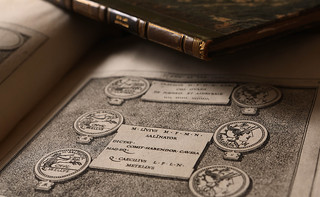 The Asylum is compiling contributions for a special “Bibliomania Origin Stories” issue and we would love to hear yours! Share the story of how you became interested in collecting
numismatic literature or when you discovered that you were a true bibliomaniac. Was there a special book or catalogue that sparked your interest or did you realize you were a collector over time? All
stories are welcome!
The Asylum is compiling contributions for a special “Bibliomania Origin Stories” issue and we would love to hear yours! Share the story of how you became interested in collecting
numismatic literature or when you discovered that you were a true bibliomaniac. Was there a special book or catalogue that sparked your interest or did you realize you were a collector over time? All
stories are welcome!
Articles should be approximately 1000 words and photos of your collection or special finds would be greatly appreciated. Text may be submitted as plain text or as MSWord files. Images should be as high a resolution as possible (RGB JPGs of at least 1200x1200 pixels).
Please let us know that you are interested ASAP so we can save room for you and send contributions to nbsasylum@gmail.com by August 1, 2017.
Thank you for sharing your unique story and for inspiring future numismatic bibliophiles!
Maria Fanning
Editor, The Asylum
For more information on The Asylum, see:
http://www.coinbooks.org/asylum/index.html
NEW BOOK: FORGOTTEN COLORADO SILVER
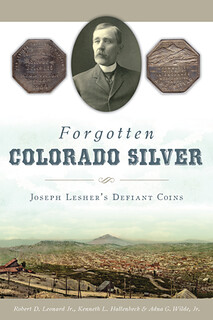 Forgotten Colorado Silver
Forgotten Colorado Silver
by Robert D. Leonard Jr., Ken Hallenbeck & Adna G. Wilde Jr.
ISBN: 978-1-4671-3525-2
$21.99 | 128 pp. | paperback
At the turn of the last century, miner Joseph Lesher attempted to raise the price of silver by privately minting octagonal “Referendum souvenir medal” coins with values of $1.25 or $1. They were common in Victor, Cripple Creek, Denver, Colorado Springs, Pueblo, Salida, Grand Junction, and other places in Colorado in the days after William Jennings Bryan fought unsuccessfully for free silver. Surviving an initial dust-up with the Secret Service, Lesher found a loophole to place them in circulation in 1900 and 1901. Today, coin collectors pay more than $1,500 for one. This is the story of Joseph Lesher and his audacious private mint, along with the merchants in the mining towns and elsewhere who supported him.
Joseph Lesher’s octagonal silver coins are rare today, with collectors paying over $1,500 each.
The book replaces previous booklets on Lesher Dollars published in the 1950s and 1970s, giving accurate information on the dies used and their disposition, and illustrations of every type.
Included are tantalizing tidbits about lost hoards and treasures of Lesher Dollars.
About the Authors
Lead author ROBERT LEONARD, a Fellow of the American Numismatic Society, New York, has studied private coinages, including Lesher Dollars, since the 1960s. Author of over 100 numismatic articles and lead author of California Pioneer Fractional Gold: Historic Gold Rush Small Change 1852-1857 and Suppressed Jewelers’ Issues 1858-1882 by Walter Breen and Ronald J. Gillio, Second Ed., this is his third book. He examined the pertinent Secret Service records in the National Archives and Farran Zerbe’s papers in the archives of the American Numismatic Society, in addition to verifying and expanding the genealogical research presented here.
A former insurance executive, KEN HALLENBECK moved to Colorado Springs in 1977 to assume the post of curator of the Museum of the American Numismatic Association, leaving in 1983 to found Ken Hallenbeck Coin Gallery Inc. He has held other positions with the ANA, including President, 1989-91 and Acting Executive Director, and is a former Director of the Colorado Springs Pioneer Museum Foundation. He has been studying and dealing in Lesher Dollars since the 1980s.
A graduate of The Citadel, the late ADNA WILDE had a distinguished military career from 1943-1968, serving in Italy, Korea, and Vietnam. He began collecting coins in 1947, held elective office in the American Numismatic Association including President, 1981-83, and was inducted into the ANA Numismatic Hall of Fame in 2002. A long-time student of Lesher Referendum Dollars, his groundbreaking study, “Lesher Referendum Medals: Where are They Today?” (The Numismatist, February 1978, pp. 229-48), received the First Place Heath Literary Award and was essential for the understanding of these issues.
Bob Leonard adds:
It's available for preorder already from Amazon.com and BarnesandNoble.com, and publication is less than a month away. I hope readers enjoy this fresh--and exhaustive--look at the Lesher Dollar series. See if you can find all the answers to the attached trivia questions!
Which Lesher Dollar issuer:
- Is buried in the same cemetery as Mickey Rooney?
- Spent time in an insane asylum?
- Worked as a “legal adjuster” for a traveling circus?
- Has an airport named for his wife?
- Supervised his jewelry store from an easy chair on a balcony?
- Ended his life as a poultry farmer?
- Vanished and was never seen again?
- Assaulted a co-worker with a paperweight?
- Was descended from John Alden, who arrived on the Mayflower?
- Prospected for uranium?
- Filed to divorce his wife—on grounds of “cruelty and desertion”?
- Went bankrupt?
For more information, or to order, see:
Forgotten Colorado Silver: Joseph Lesher’s Defiant Coins (https://www.arcadiapublishing.com/Products/9781467135252)
NEW BOOK: GOLD: EVERYTHING YOU NEED, 2ND ED.
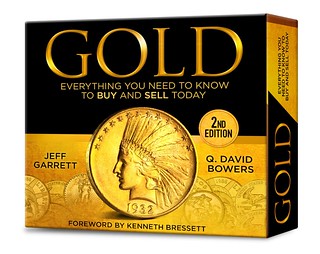 Whitman Publishing will release a newly updated 2nd edition of its award-winning book GOLD: Everything You Need to Know to Buy and Sell Today, by Jeff Garrett and Q. David Bowers. It
is available for preorder online (including at www.Whitman.com) and will be sold at bookstores and hobby dealers nationwide for $14.95.
Whitman Publishing will release a newly updated 2nd edition of its award-winning book GOLD: Everything You Need to Know to Buy and Sell Today, by Jeff Garrett and Q. David Bowers. It
is available for preorder online (including at www.Whitman.com) and will be sold at bookstores and hobby dealers nationwide for $14.95.
The book’s contents include a foreword by Kenneth Bressett (senior editor of the Guide Book of United States Coins), and chapters entitled “Gold: What is it, and Why is it Valuable?”; “The Recent Gold Boom”; “Selling Your Gold”; “Buying Gold”; “Deal With the Experts”; “Avoiding Counterfeit and Altered Gold Coins”; “Quick Answers to Frequently Asked Questions”; “Glossary of Gold-Related Terms”; and “More Resources.”
The uniquely formatted 120-page hardcover book comes in a sturdy library-quality slipcover. Inside, the text and illustrations are accompanied by pullouts printed with valuable insider information. These include technical content such as weight conversion tables, bullion-value charts, melt value by karat and pennyweight, and federal coinage specifications. “These pullouts are handy for taking to coin shows, pawn shops, flea markets, and other places where gold is bought, sold, and traded,” said Whitman publisher Dennis Tucker. They also include fascinating replicas of historical documents such as President Franklin Roosevelt’s executive order 6102 of April 5, 1933, which recalled billions of dollars worth of gold coinage and stopped the hoarding of gold coins, bullion, and certificates during the Great Depression.
The book’s audience includes experienced coin collectors and investors, as well as newcomers who have never bought or sold gold but are interested because of mainstream news coverage. It covers the history of gold going back to ancient times; market trends since 1933; U.S. and foreign gold coins; modern and older bullion and trade coins; scrap gold, jewelry, and gold works of art; how to grade gold coins; the pros and cons of various buying and selling venues; using the Internet; pennyweights, karats, grams, fineness, melt value, and other technicalities; the market effects of recent world events; contact information for world mints that sell gold; and more.
Bressett, in his foreword, wrote, “Whether you intend to buy, sell, hold, or ignore this noble metal, you will have all of your questions and concerns addressed in this handy book. Through charts, insider tips, and clear concise directions you will be able to maximize the satisfaction of your transactions.”
The coauthors are award-winning numismatic researchers. Q. David Bowers is a coin dealer, auctioneer, and writer who serves as numismatic director for Whitman Publishing and research editor of the Guide Book of United States Coins (the best-selling “Red Book” annual coin-price guide). Jeff Garrett is known as a coin dealer and an active hobby promoter; he is the president of the American Numismatic Association and valuations editor of the Red Book.
For more information, or to order, see:
GOLD: Everything You Need to Know to Buy and Sell Today, 2nd
Edition (https://www.whitman.com/store/Inventory/Detail/GOLD-Everything-You-Need-to-Know-to-Buy-and-Sell-Today-2nd-Edition+0794845185)
To read the earlier E-Sylum articles, see:
BOOK REVIEW: GOLD: EVERYTHING YOU NEED TO KNOW TO BUY AND SELL TODAY (http://www.coinbooks.org/esylum_v13n28a06.html)
BOOK REVIEW: GOLD: EVERYTHING YOU NEED TO KNOW TO BUY AND SELL TODAY (http://www.coinbooks.org/esylum_v13n29a06.html)
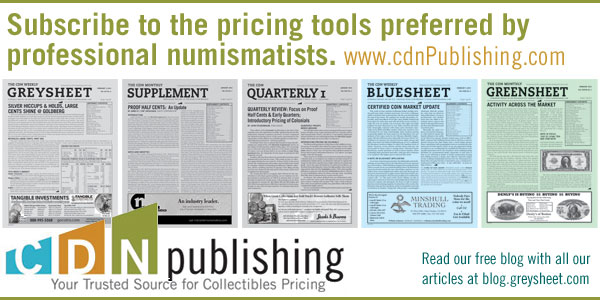
NEW BOOK: LE FRANC POCHE
Reader Marielle Leblanc of the French firm CBG writes:
This will be a pleasure for us to introduce to E-Sylum subscribers the 11th edition of our French coins price guide Le Franc. This 20th anniversary edition is a special one, pocket version bilingual French and English.
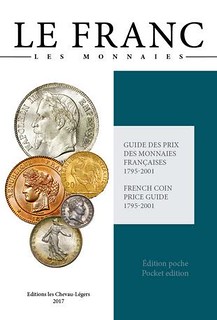 In 2016, the French coin guide book Le Franc is celebrating its 20th anniversary. It is now a key reference work for all professionals and collectors of modern French coins. As the
title indicates, it is dedicated to French coins from the French Revolution to the end of the Franc (1795-2001). Le Franc is a comprehensive numismatic book which combines a typology and
prices guide as well as a research, analysis and study manual. This work is the fruit of 20 years of research, study and indexing by CGB’s team of professional numismatists under the supervision of
Joël Cornu (j.cornu@cgb.fr), CGB’s Chairman.
In 2016, the French coin guide book Le Franc is celebrating its 20th anniversary. It is now a key reference work for all professionals and collectors of modern French coins. As the
title indicates, it is dedicated to French coins from the French Revolution to the end of the Franc (1795-2001). Le Franc is a comprehensive numismatic book which combines a typology and
prices guide as well as a research, analysis and study manual. This work is the fruit of 20 years of research, study and indexing by CGB’s team of professional numismatists under the supervision of
Joël Cornu (j.cornu@cgb.fr), CGB’s Chairman.
Since its first edition, almost 240,000 copies of Le Franc have been sold. For its 20th anniversary, CGB is offering this new updated version that’s both handy and accessible to a broader audience, titled Le Franc Poche.
Designed for novice or intermediate collectors, or even for advanced numismatists needing a quick and handy reference, this new bilingual English-French pocket edition is an innovative approach to a coin price guide. Like in any price guide, you will find coin identification and pricing information in it, but that’s not all.
Le Franc Poche is a comprehensive work which also includes detailed user instructions, a historical presentation of French coins, a complete review of general engravers' privy marks and privy marks of French mint directors, an illustrated numismatic glossary as well as advices on how to collect modern French coins.
The identification and pricing section includes every monetary type listed for six grades. Detailed explanations for six grades and full color photographs of superb quality are provided with each type, as well as useful numismatics data such as diameter, weight, metal, purity, edge and total mintage for each type.
Pricing information in Euros is also provided for six grades according to the Sheldon scale for each type, date and mint, including varieties. Since the beginning of the twenty-first century, CGB has been a pioneer in using the numeric Sheldon Grading System for modern French coins. Likewise, the description of various grades for each type will assist you in developing and enriching your knowledge and fine-tuning your grading capacities. In the end, thanks to all the tools offered in Le Franc Poche, collectors will be able to identify, classify, grade and assess the coins in their collection on their own.
The coin reference book then concludes with the pricing of the Mint and Proof sets (Fleurs de Coins, Belle Épreuve and Brillant Universel) issued by the Monnaie de Paris from 1964 to 2001.
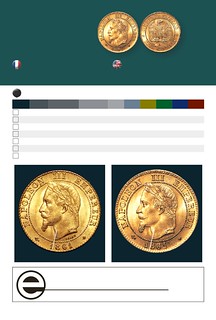
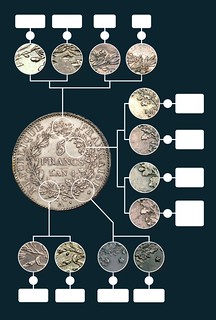
As with every new edition of Le Franc, the prices presented in Le Franc Poche have been completely revised and verified one by one. To accomplish this, CGB has used the 25,000 photographs assembled in the Ideal Collection database (a list of the most beautiful French coins known for each type and variety - http://www.collection-ideale-cgb.net/), the 21,000 results from the last Live Auctions organized by CGB, the results of the weekly CGB e-auctions and the price trends for the 150,000 coins available or sold in fixed-price catalogs or on our on-line e-shops. Of course, market observation as well as comments, verifications and remarks from editors and professionals specializing in the reference period have also been taken into account. The CGB team thus processes and analyzes 29,000 prices, one by one. Once they are set, those prices are cross-checked by a second team.
The public concerned is international. The Internet revolution and the emergence of social networks have upended the traditional rules of the numismatic arena. French numismatics – so rich and diverse – is now open to the world. This new edition is thus completely bilingual in both French and English. Today, there is a wide and abundant range of information sources, but it is impossible to have an informed opinion about a coin without solid numismatic knowledge and experience. Before buying, collectors need to gather information, compare, read specialized publications, peruse fixed-price and auction catalogs, analyze quality and prices, surf the Internet or search through archives such as CGB's. As a true gateway to the world of French numismatics, Le Franc Poche will help collectors from all over the world to grade and quote their French modern coins as close as possible to the market rate with no more language barriers.
The bilingual reference price guide Le Franc Poche is an invaluable aid for professionals and collectors who would like to build and enrich their modern French coin collection with knowledge and confidence.
Specifications of the Franc Poche – 2016:
- Size 10.5 x 15.5 cm
- 592 pages
- Over 1,000 color photos
- Softback binding
- All quotations reviewed and updated
- All monetary types of modern French coins
- Bilingual English-French
- Quotes in €
- Public sale price €14.90
For more information, or to order, see:
http://flips.cgb.fr/lf2017/files/assets/basic-html/page-1.html#
NEW BOOK: ONE COLLECTOR...ONE BANKNOTE
Marielle adds:
This could be also the opportunity to present also the latest book of our publishing house Les Editions Chevau-Légers : "Un collectionneur...un billet" (One collector...one banknote). This book is not an price guide but simply a compilation of passionnate collectors answering this simple question "If there should stay just one banknote, which one would you choose ?"
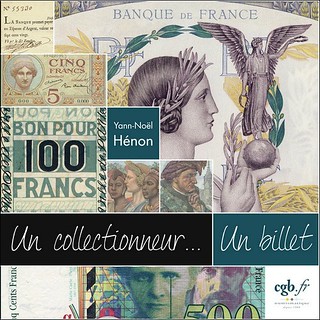 Every human on the planet has a unique relationship to objects. There are those who accompany us daily and others more punctually. Not all objects have the same identity and the same power
of attraction. Some will never make sense and others will be very valuable to us.
Every human on the planet has a unique relationship to objects. There are those who accompany us daily and others more punctually. Not all objects have the same identity and the same power
of attraction. Some will never make sense and others will be very valuable to us.
As far as the subject of this book is concerned, the objects we are going to talk about are banknotes! In the pages that follow, about thirty tickets have been selected to tell you a more personal story through the testimony of passionate collectors.
The idea of this book germinated in my mind when I showed my collection to friends for the first time. I was delighted and proud to present my binders, until one of the hundreds of cuts carefully classified in their plastic sleeves asked me which of my bills I preferred? I was disappointed, like frozen. It seemed impossible to answer. It was therefore naturally tempting for me to investigate and test other collectors on this fundamental question: "And if you were to have only one banknote, which one would you choose?"
Price: 20.00 €
Author: HÉNON Yann-Noël
Publisher: CGB
French language
Characteristics: Paris 2017, paperback, 88 pages, color illustrations
Weight: 500 g.
To read the complete article, see:
lu10 - Un collectionneur... Un billet ! HÉNON Yann-Noël
(http://www.cgb.fr/un-collectionneur-un-billet-henon-yann-noel,lu10,a.html)

NEW BOOK: QUEBEC DAIRY TOKENS, 3RD EDITION
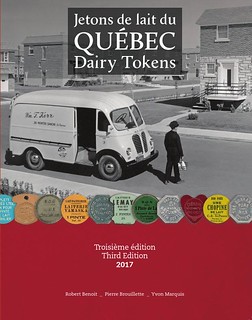 This Third Edition (bilingual French & English) Catalog of Quebec Dairy Tokens is presented in a new format (8.5” x 11”), with about 400 pages, including 350 in color. Many new
tokens have been discovered since the last issue published 25 years ago. In addition to the tokens, one will read about the history of some Dairies and their owners.
This Third Edition (bilingual French & English) Catalog of Quebec Dairy Tokens is presented in a new format (8.5” x 11”), with about 400 pages, including 350 in color. Many new
tokens have been discovered since the last issue published 25 years ago. In addition to the tokens, one will read about the history of some Dairies and their owners.
The regular price of the catalog has been fixed at $69.95 but it is offered in pre-order (until July 23rd) at the special price of $54.95 (plus postage). It will be also available at this price
during the RCNA Convention in Boucherville, July 21-23, 2017.
THE NEWMAN NUMISMATIC PORTAL
Newman Numismatic Portal Welcomes ANA Readers to the ANA Edition of The E-Sylum
 We welcome ANA readers to this first issue of The E-Sylum ANA Edition. Numismatic information is increasingly created and accessed through electronic means, and we are excited to see
this well-established weekly newsletter distributed to the ANA membership. The Newman Numismatic Portal is likewise an electronic, online initiative, with the charter of gathering together the
literature and image of numismatics, particularly American numismatics. Sponsored by the Eric P. Newman Numismatic Education Society (EPNNES), the Newman Portal launched operations in November 2014
under a $2 million grant made by EPNNES to Washington University in St. Louis (WUSTL).
We welcome ANA readers to this first issue of The E-Sylum ANA Edition. Numismatic information is increasingly created and accessed through electronic means, and we are excited to see
this well-established weekly newsletter distributed to the ANA membership. The Newman Numismatic Portal is likewise an electronic, online initiative, with the charter of gathering together the
literature and image of numismatics, particularly American numismatics. Sponsored by the Eric P. Newman Numismatic Education Society (EPNNES), the Newman Portal launched operations in November 2014
under a $2 million grant made by EPNNES to Washington University in St. Louis (WUSTL).
The Newman Portal is administered by the University and has two full-time staff allocated to the project, in addition to a large group of students. To date, the Newman Portal has digitized over one million pages of numismatic material. Many regional and specialty organizations have contributed materials to the Newman Portal, and these may be accessed in the Library portion of the website. In addition, the Newman Portal now contains over 4,000 American numismatic auction catalogs. Any inquiries regarding the site may be directed to Len Augsburger, Newman Portal project coordinator, at leonard.augsburger@wustl.edu.
Link to the Newman Numismatic Portal:
https://nnp.wustl.edu/
NOTES FROM E-SYLUM READERS: JUNE 18, 2017
Chopmark Collectors Club Founder Everett R. Jones
Chopmark Collectors Club member 302 A. Bernard Olij of Malang Indonesia writes:
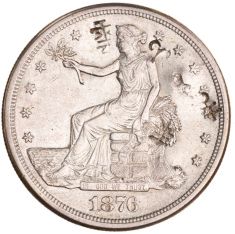 I'd like to correct something I read in the Whitman Publications article Chopmarked Coins Featured in 3rd Mega Red". The founder of the Chopmark Collectors Club is Mr.
Everett R. Jones of California, USA. Mr. Colin Gullberg is the current editor of our Chopmark News. In the past I have had some contacts with Mr. Jones and I think he deserves the honor to be
mentioned here. Mr. Gullberg is doing a wonderful job as our editor and has revived the CCC at some time.
I'd like to correct something I read in the Whitman Publications article Chopmarked Coins Featured in 3rd Mega Red". The founder of the Chopmark Collectors Club is Mr.
Everett R. Jones of California, USA. Mr. Colin Gullberg is the current editor of our Chopmark News. In the past I have had some contacts with Mr. Jones and I think he deserves the honor to be
mentioned here. Mr. Gullberg is doing a wonderful job as our editor and has revived the CCC at some time.
Colin Gullberg writes:
Yes, Everett was the founder of the CCC in 1990. He passed away two years ago. I wrote the chapter on chopmarks for the Mega Red Book but not the press release.
Dennis Tucker writes:
I regret the typo that misidentified Colin as the CCC’s founder without mentioning Everett Jones.
For more information on Jones, see:
Everett Raymond Jones
(http://www.legacy.com/obituaries/name/everett-jones-obituary?pid=1000000170114389&view=guestbook&page=2)
To read the earlier E-Sylum article, see:
CHOPMARKED COINS FEATURED IN 3RD MEGA RED (http://www.coinbooks.org/v20/esylum_v20n24a03.html)
New York City Mayor Philip Hone
Dave Hirt of Frederick, MD writes:
In last week's post on the Erie Canal medal, it mentions Philip Hone, the Mayor of NYC at that time. When his estate was sold in 1852 it included numismatics. The catalog is listed in Gengerke under E.H. Ludlow on 04/28/1852. I remember seeing this catalog offered in a Woodward sale in the 1860's. Woodward stated that it was mostly paintings and other things, but had a few numismatic items.
To view the Newman Numismatic Portal results, see:
https://nnp.wustl.edu/library/searchwithterms?searchterm=philip%20hone
To read the earlier E-Sylum article, see:
MORE ON THE ERIE CANAL MEDAL (http://www.coinbooks.org/v20/esylum_v20n24a09.html)
Lead Token Lookalikes: England and Lanka
Regarding the Davisson's newsletter article, Kavan Ratnatunga of Sri Lanka writes:
Some of the designs of English lead/pewter tokens illustrated in referenced http://www.britnumsoc.org/publications/Digital%20BNJ/pdfs/1983_BNJ_53_7.pdf and http://www.britnumsoc.org/publications/Digital%20BNJ/pdfs/1984_BNJ_54_11.pdf are interestingly close to lead tokens over 1000 years older issued in Lanka with Brahami inscriptions and illustrated in http://coins.lakdiva.org/OBRW/lead_tokens.html
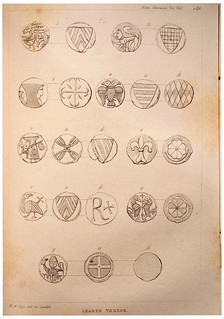
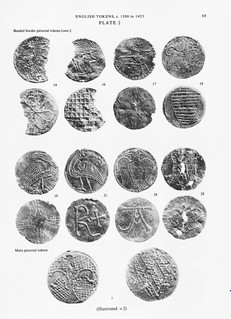
English Lead tokens
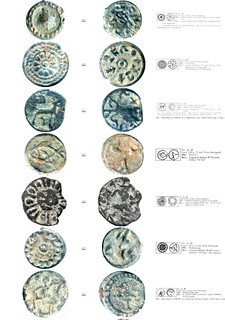
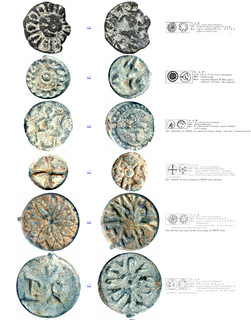
Lankan Lead tokens
To read the earlier E-Sylum article, see:
ENGLAND’S FIRST TRADE TOKENS (http://www.coinbooks.org/v20/esylum_v20n23a22.html)
Re-enacting The Hunley
Regarding the 'Lucky Coin' Confederate submarine SS Hunley, Ralph Langham writes:
Among other things I am a Civil War Re-enactor and at the re-enactment of Secessionville as a major in the 79th NY Cameron Highlanders we were present when the Hunley was brought up and got to see a mock-up of it on Boone Plantation in North Charleston. Very impressive, Boone Plantation is the one usually shown in the movies about the Civil War.
To read the earlier E-Sylum article, see:
HOW LUCKY COIN SUBMARINE HUNLEY WORKED (http://www.coinbooks.org/v20/esylum_v20n24a15.html)
More on Dale Birdsell
Regarding last week's mention of Dale Birdsell, Pete Smith writes:
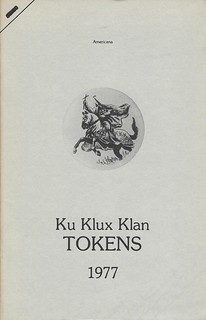 At one time I compiled a list of numismatic authors who served prison time. I lost track after the first half dozen. Dale Birdsell was one of them.
At one time I compiled a list of numismatic authors who served prison time. I lost track after the first half dozen. Dale Birdsell was one of them.
Dick Grinolds said that he was not aware of Birdsell's current status. He is still dead. Dale Estin Birdsell was born on June 4, 1920, and died on April 8, 1998. He was a veteran of the Army during World War II and is buried in Quantico National Cemetery in Virginia.
He wrote Ku Klux Klan Tokens, published in 1977 with a second edition published in 1981. Indeed he had insider information as a member of the Klan and a KKK organizer in Arkansas.
Birdsell wrote checks to support the Klan. He was charged with writing more than a million dollars worth of bad cashier's checks. In court he asserted that he was the reincarnation of Nathan Bedford Forrest, founder of the KKK.
To read the earlier E-Sylum article, see:
NOTES FROM E-SYLUM READERS: JUNE 11, 2017 : More on The Invisible Empire Tokens
(http://www.coinbooks.org/v20/esylum_v20n24a10.html)
Decline and Fall In Seven Short Book Spines
Dave Lange writes:
I was perusing the blog messynessychic.com and came across this interesting book photo that might be nice to share with readers.
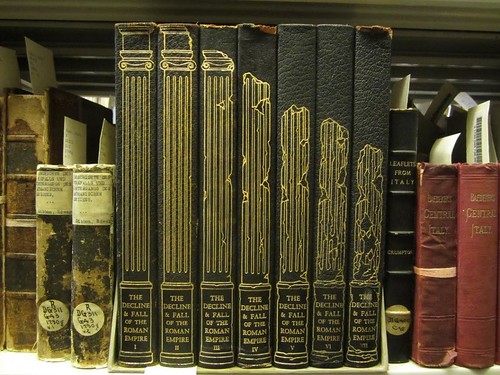
Coins Salvaged From the SS Cairo
Regarding the salvage of a long-lost WWII coin treasure from the SS Cairo, web site visitor Ian Marshall of the south of France writes:
I saw the article on your web site about the salvage of Indian rupees from city of Cairo sunk by uboat in WWII. The captain was my uncle so I received two coins. With the coins I have the letter from the salvage company explaining that only a few were saved from meltdown for relatives of the survivors. Captain Rogerson was my uncle and won an OBE (Order of the British Empire) for saving so many lives.
To read the earlier E-Sylum article, see:
SS CITY OF CAIRO COIN TREASURE SALVAGED (http://www.coinbooks.org/esylum_v18n16a32.html)
More the Medal of Honor
Dennis Forgue writes:
Just as a sidebar to the Medal of Honor, I remember back in my days at Rarcoa. I ran the Orders and Decorations Department. We sold US medals and had virtually everything in stock. Trading on medals was somewhat confusing and many in the business used to advertise that you needed to send a stamp along with your payment in order to make it a "trade" not a sale. This really was not true.
At one time we had a set (3 different-Army, Navy, Air Force) of unissued MOH's on display in the window. We got a visit from the FBI responding to a complaint someone had filed. They said they normally did not care about it but had to follow up on the complaint. We decided to eliminate US medals completely and donated a complete set of US medals to the ANA. The MOH's were Unissued, and how those became available was interesting.
After the Vietnam Nam war we had a former supply clerk come in with a group of Navy unissued medals including a MOH. He said that the larger ships in the war had a stock of medals for field awards. At the end of the war when many ships were being decommissioned they were given orders to "deep six" all medals to avoid paperwork and shipping. Of course many went home in duffle bags instead of the ocean. Despite of a so called ban on the sale of all medals, many vets came looking for replacement of various medals for ones they had lost, carrying letters from the War Dept telling them they did not have them and to go to a dealer and buy them. Typical Government Confusion I suppose.
To read the earlier E-Sylum article, see:
NOTES FROM E-SYLUM READERS: JUNE 11, 2017 : More on the Navy Medal of Honor (http://www.coinbooks.org/v20/esylum_v20n24a10.html)

STILL MORE ON 'ABER NIT'
Last week Giordano Sereno wrote:
I couldn't find this expression. But "Aber Initio" in Latin means "Since the beginning". Is it possible that correct expression was "Aber Initio"?
This is actually "ab initio" rather than "aber initio". It might do on a mis-hearing but is unlikely.
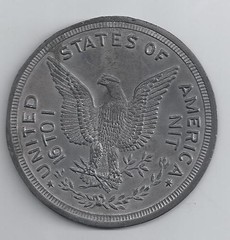 Did you or anyone else check this reference in the process:
Did you or anyone else check this reference in the process:
http://www.coinbooks.org/esylum_v15n22a12.html
Sorry if it's already been mentioned but I thought I'd raise it since it just popped up with a Google search now. I suspect "Not In Trust" is fanciful, and still just means "not" even without the word "aber" on the example illustrated in the 2012 item.
I read somewhere that any etymology that claims to be based on an acronym prior to 1900 is almost certainly a later concoction, and most likely wrong.
To read the earlier E-Sylum articles, see:
ANSWER: WHAT DOES N.I.T. ON BRYAN MONEY STAND FOR? (http://www.coinbooks.org/esylum_v15n22a12.html)
QUERY: BRYAN MONEY "ABER NIT" INSCRIPTION (http://www.coinbooks.org/v20/esylum_v20n23a28.html)
MORE ON 'ABER NIT' (http://www.coinbooks.org/v20/esylum_v20n24a11.html)
MORE ON THE NEW DEPARTURE BELL COMPANY 'TOKEN'
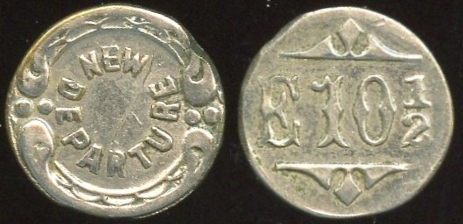
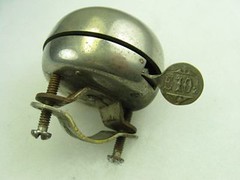

Eric Vanhove writes:
It was part of the ringer for the New Departure Bicycle Bell. Looks to me like someone cut it off of the ringer and filed it down to make it look like a coin.
Julia Casey also came up with this, and like Eric, she used the worthpoint.com database. She writes:
I did a little digging into this mystery utilizing the information provided by John Phipps about the New Departure Bell Company. I found the following listing for a New Departure bicycle bell - Model E10 1/2!
I also found where this company advertised bell promotional giveaways. I have attached an ad from Eau Claire Leader (Wisconsin) April 1, 1897 which states:
If you want a bicycle bell free, write us
and we'll tell you how to get it - but you must
mention the "LEADER." The New Departure
Bell Co., Bristol, Conn.
Looking at that bell I wonder if this piece isn't even a token at all - but is actually a broken off thumb tab from the bell that activates the ringer! And if you look at the auction "token" you can see a broken area at the edge.

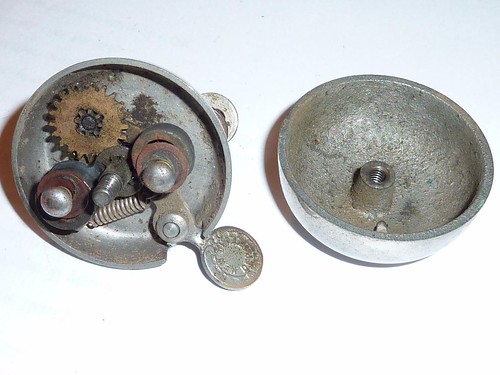
To read the complete Worthpoint listings, see:
ANTIQUE SMALL NEW DEPARTURE BICYCLE BELL E10 1/2 WORKS!
(https://www.worthpoint.com/worthopedia/antique-small-departure-bicycle-bell-151702456)
RARE EARLY NEW DEPARTURE BELL COMPANY BICYCLE BELL - MODEL E10 1/2
(https://www.worthpoint.com/worthopedia/early-departure-bell-company-bicycle-1800841484)
Regarding the baggage tag overstrike, Bill Miller of Denton, MD adds:
Thank you and all the people at your website for helping me to identify my "mystery" token. It's good to have access to so many bright people. I don't think I could have come up with a solution in a dozen years.
To read the earlier E-Sylum articles, see:
NOTES FROM E-SYLUM READERS: JUNE 11, 2017 : The New Departure Bell Company (http://www.coinbooks.org/v20/esylum_v20n24a10.html)
MYSTERY BAGGAGE TAG OVERSTRIKING SOLVED (http://www.coinbooks.org/v20/esylum_v20n23a10.html)
A “RED BOOK” FOR TOKENS AND MEDALS?
Two weeks ago, TAMS president Fred Holabird provided a great overview of The Allure of The Token and Medal Society. Several paragraphs, however, were devoted to why compiling a “Red Book” of tokens and/or medals would be “a near impossible task”. Last week, my good friend David Alexander, who is the founder and past-president of the Medal Collectors of America, amplified Fred’s sentiment, saying that “while a comprehensive American medal catalogue is a great idea, it is also impossible to achieve, thanks to the sheer size of the field”, estimated at over one million items for an American catalogue alone. Both pointed to a future of individual authors publishing books on very narrow, specific topics.
While a comprehensive catalogue of medals and/or tokens could not be quickly assembled, I believe it would indeed be possible, even given the number of potential entries for a worldwide effort. Ultimately, the pages would read more like Bob Julian’s Medals of The United States Mint or Laurence Brown’s British Historical Medals than the Red Book, and be web-based rather than a printed book. Instead of being mostly tables of dates, mint-marks, and valuations, with a little background information around the edges, like the Red Book, it would look more like the medal listings in a Stack’s Bowers, Heritage, or Baldwin’s online auction catalogue. It could include prices, like Chris Eimer’s British Commemorative Medals and Their Values, though this commercial (as opposed to descriptive/scholarly) aspect would be somewhat more difficult to assemble and maintain.
Here are a few thoughts on what it would take to assemble such a catalogue:
Crowdsourced – Yes, the task would be far greater than a single person could achieve in a lifetime, but hundreds of dedicated numismatic contributors could get the job done, just as millions of individual contributors to Wikipedia have now written 40 million articles (27 billion words) in 293 languages, roughly a thousand times the volume of the last printed edition of the Encyclopedia Britannica. Richard Greever’s token database (www.tokencatalog.com) is approaching a half-million listings, with nearly 100,000 added over the last two years and now over 300,000 images, and provides a good framework for the concept.
Web-based – Obviously, putting such a catalogue on the web would be necessary for logistical and financial reasons, but would also allow for continuous enhancements and updating as discoveries are made, and more medals and tokens are produced. A few software choices would be required, but several excellent options exist.
Standardized format – The catalogue would be driven by an underlying database, which would require standard templates for both inputs and outputs. Dick Johnson once outlined a standard medal listing format, which I refined for NeoCollect (see The MCA Advisory, February, 2010), but could be whatever is agreed upfront by the sponsors.
Basic listing requirements – Some minimal, basic information should be required of every listing, such as a description of obverse and reverse devices and legends, size and weight, and metal. Photos might not be required, but just strongly encouraged, with an option to add extra photos showing unusual details, such as edge marks. Some boilerplate terms and conditions would also be required for both legal and practical reasons.
Dedicated moderation – As with Wikipedia, listings and short background articles contributed by individuals would have to be subject to review, sorting/editing, and possibly even dispute resolution in cases where opinions may differ. This task should not be overwhelming if the basic listing requirements are well thought-out, explained clearly, and enforced.
Technology expertise/oversight – While the technology needed for such an effort is not cutting edge, or even that complicated, the system would need continual updating, as software/standards evolve over time. The necessary cybersecurity and controls would also require ongoing technical expertise and oversight.
Enticement to volunteer contributors – Even though numismatic authors rarely (ever?) make money from their writings, most get a great deal of psychic satisfaction from the recognition of their expertise and work. Some similar recognition and gratification would probably be required for all of the volunteer effort, possibly in the form of author citations for particularly good listings and/or frequent contributions.
Ongoing non-profit sponsorship – For authors of the listings to volunteer significant effort, they need to be assured that their work is for the good of the greater numismatic society, not a for-profit entity, and that the sponsoring organization and this catalogue will survive indefinitely. The ANA, ANS or Newman Numismatic Portal seem like obvious candidates, though each may have its own mission, scope, operating, financial and/or other issues at this time.
Promotion and support – In order to gain traction and ultimately become self-sustaining, some amount of upfront promotion (marketing) would be required.
Professional endorsement – Separate from the possibility of starting with auction house records – which are already housed in proprietary databases – to jump-start the listings, the support of the major firms would be important. While some might balk at making their records available on a public website, the benefits of encouraging broader collecting and standardizing attributions could significantly increase their revenue base and reduce cataloguing costs.
Modest funding – Such an effort would not be expensive, but would require some modest funding, perhaps a few tens of thousands of dollars to establish and a few tens of thousands of dollars annually for hosting, software updates, security oversight and perhaps a paid moderator/curator. User fees might cover some or all of this, though most online media is still expected to be and is mostly free.
It is difficult to know why some crowd-sourced initiatives catch on and others don’t, and whether this project might ultimately gain traction. Perhaps a comprehensive catalogue of medals and/or tokens is impossible in our lifetime, but the hurdles are those of leadership and will, not technical possibility or skill.
These factors come to mind in response to John’s proposal:
1. Catalogs of tokens and medals should be separate.
2. It is mandatory the catalog must have valuations.
3. Since medals do not circulate they do not need multiple condition valuations (like coins do).
4. Award medals are often in a number of compositions (which affects valuations).
5. Award medals are often issued in a number of years (with knowledge of first and last year).
6. Inscribed medals with recipient’s name affects valuation (always unique, degree of fame and collector interest determine valuation).
7. Medals issued in a number of years often have lettering or design changes (revisions are varieties, affecting valuation).
8. Some medals do not deserve to be listed for lack of collector interest or other reasons (would you list a medal for a few cents or its scrap metal value?}.
For all the reasons above, while not impossible, would be extremely time consuming to compile a medal catalog. Establishing medal valuations is a subjective decision for each piece rather than for for a group of similar medals Often, as with named recipient medals requires extensive research of the person involved. Here, no one is better than Joe Levine for his auction catalogs.
It is better to have a medal appraised rather than looking it up in a standard catalog. There are so many factors which must be taken into consideration. You do not have this for coins, so you can have a Red Book of coins.
Having said all that, organizations John named can assist the medal field by sponsoring the publishing of topical medal catalogs. Medal collectors collect by topics. A published catalog aids this activity, lists all necessary items to form a “complete” collection. It can include the lore of some medals and the appeal of the topic
Organizations should sponsor topic medal publishing, offer grants to authors and enact other incentives for this to happen.
John Sallay adds:
I share many of Dick's views, though I believe that valuations would be more like icing on the cake than the cake itself. For example, the valuation guides to Bob Julian’s mint medal book or Neil Musante’s Washington medal book are nice to have, but are not central to the value of those publications. And BHM never had a valuation guide, but is the standard for British medal collectors.
To read the earlier E-Sylum articles, see:
THE ALLURE OF THE TOKEN AND MEDAL SOCIETY (http://www.coinbooks.org/v20/esylum_v20n23a12.html)
NOTES FROM E-SYLUM READERS: JUNE 11, 2017 : More on the Token and Medal Society
(http://www.coinbooks.org/v20/esylum_v20n24a10.html)
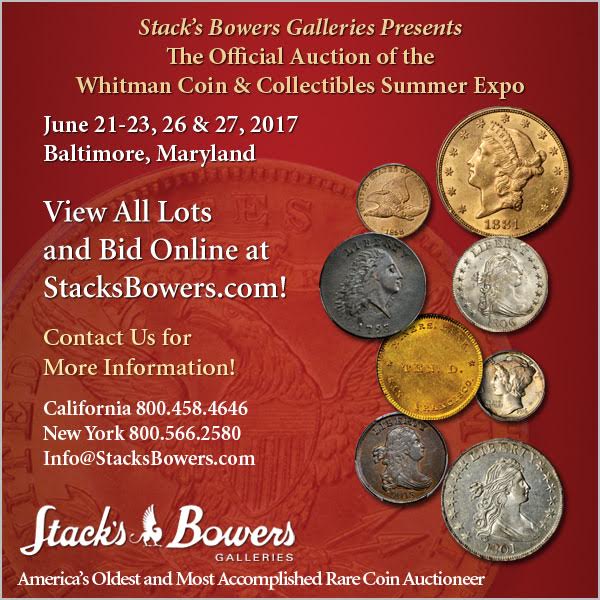
VOCABULARY TERM: INSERT DIE
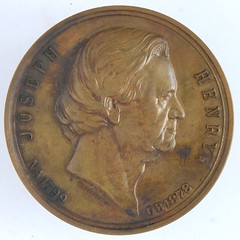
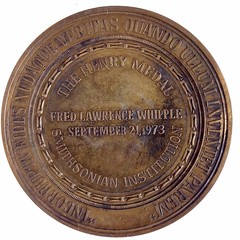
The entire center panel on the reverse of this medal is an insert, separately engraved, to be inserted in a die with the center hollowed out to receive the insert. The specially prepared hollowed out die -- the insert die – with the insert in place produces raised lettering when struck. This method of medal making is used where a number of raised relief lettering is needed using the same obverse die. The raised edge of the insert is most obvious at the lower right just inside the chain border on the reverse of this medal.
Insert Die. A special die and its supplemental part – an insert – employed to produce raised lettering on a medal. The die to contain the insert is machined with a cavity by a tool and die maker. The cavity has bevel sides. The insert blank is made of steel, also by a tool and die maker; it is shaped to fit the cavity in the insert die The insert blank is engraved incuse by a hand or machine engraving to contain the desired lettering. During striking the insert lies loose in the base die – only one side of a medal may have an insert and this die must be in the lower position in the press (it would fall out of the die in the upper position). Raised lettering is produced by this method, but always a tiny raised ridge outlining the insert appears as FLASH on a piece so struck; this line is diagnostic of the use of an insert. It may be removed by chasing on the struck piece if considered too obvious and unwanted.
A small or large quantity of medals with raised lettering can be made efficiently by the use of inserts from one SETUP of the press. Each insert must be engraved separately with the recipient’s name and placed by hand in the insert die before striking. The award medals of the Columbian Exposition, for example, were struck by insert dies. (See adjacent box.)
The first use of insert dies in America occurred during the Civil War. Numismatist Q. David Bowers found this technology was employed by Boston diesinker Joseph Merriam in 1863. From 1870s to 1920s billiard supply manufacturers provided tokens to their clients with their name (and sometimes the denomination) struck by insert die on the reverse. The tokens bore the advertisement of the billiard company on the obverse. Over two dozen such firms made tokens for use by billiard parlors, the tokens often bore an illustration of a pool table.
Any piece struck by an insert die without its insert would contain a large shapeless raised lump resulting from the cavity. On the opposite side would be a depression or GHOSTING effect as metal
in the blank is drawn toward the cavity. See DIES AND DIEMAKING.
CLASS 04.4
Looking for the meaning of a numismatic word, or the description of a term? Try the Newman Numismatic Portal's Numismatic Dictionary at: https://nnp.wustl.edu/library/dictionary
COLIN EDWARD KING (1862-1921)
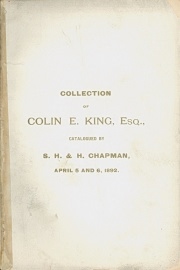 Colin Edward King (1862-1921), was born in Indiana on April 13, 1862, son of Edward King (1818-1888), a native of Connecticut and president of the Indianapolis and Saint Louis Railroads,
and Rebecca Jane Suydam (1834-1909), a native of New York. He was a member of the Sons of the American Revolution.
Colin Edward King (1862-1921), was born in Indiana on April 13, 1862, son of Edward King (1818-1888), a native of Connecticut and president of the Indianapolis and Saint Louis Railroads,
and Rebecca Jane Suydam (1834-1909), a native of New York. He was a member of the Sons of the American Revolution.
He studied at Butler College (now University), Indianapolis, Indiana. He was a member of Sigma Chi. He was elected Class Prophet. He was the Delegate to the Thirteenth Biennial Convention, Grand Rho Chapter Sigma Chi. He was a student of Catherine Merrill a well-known writer. His school diaries are preserved in the Butler Library Archives and have been used by researchers and published in part regarding American nineteenth century English composition and literary criticism. His studies brought him into collecting ancient Greek and Roman coins.
From 1883-1884 he worked for the Chicago and Alton Railway.
In 1887, he is listed in the Indianapolis City Directory as the Chief Clerk for the The Cincinnati, Hamilton and Dayton Railroad, living as a boarder at 352 Home Avenue. He worked for that railroad from 1884-1887.
He moved to New York City in February 1887, working in the General Passenger Department of the New York, Lake Erie and Western Railroad.
On June 3, 1890 he married Martha L. Wemple at Manhattan, New York.
On April 5-6, 1892, King was a consignor to the Chapman Brothers coin auction sale of 1455 lots of gold, silver and bronze coins and fractional currency at the auction house of Davis & Harvey, Philadelphia, Pennsylvania. According to the February 1892 issue of The Numismatist the auction was set to go off in February. The fine collection of ancient, medieval, European and American coins was enhanced with an extensive collection of fractional currency which was the most complete offered at that time.
One of three known at that time (now four) 1853-O NO ARROWS Half Dollar (lot 854), the grand-prize piece of the collection in this sale sold to Ed Frossard for $151. Among the ancient coins the gtand-prize piece was a superb example of a Syracuse dekadrachm (lot 56, illustrated on Plate II) sold to Lyman H. Low for $150. Most of the fractional currency was purchased by Ed Frossard. The prices realized were mixed even for 1892. The 1793 AMERI brought $14. The 1804 Uncirculated Large Cent counterstamped by Wm. W. Baldwin brought $102. An 1855 Kellogg & Company Double Eagle brought $32. An 1830 Georgia Quarter Eagle brought $62.50. The beautiful cabinet brought $110. The catalogue was illustrated with five phototype plates.
In 1895, he moved to Passaic, New Jersey. He was a member of the Passaic Club.
In 1902 he married his second wife Kate Ditmars in New Jersey.
In 1910, he worked for the Indianapolis Fire Insurance Agents Association and lived at 2108 Talbott Street, Indianapolis, Indiana, with his wife Kate D. King (1871-), and daughter Kathryn Emma King (1903-).
In 1912, he lived on Michigan Avenue, Chicago, Illinois working for a the Indianapolis Fire Insurance Agents Association.
In 1920, he still worked as a secretary for the Indianapolis Fire Insurance Agents Association and lived at 1803 North Talbott Street, Indianapolis, Indiana, with his wife Kate Ditmars King (1871-), and daughter Kathryn.
He died of arteriosclerosis and apoplexy in a downtown bank on Tuesday, November 22, 1921, at Indianapolis, Indiana. His funeral was at St. Paul's Episcopal Church and he was buried in Crown Hill Cemetery, Indianapolis, Indiana. He was survived by his wife, and daughter Kathryn Emma King, (who ten years later at age 28 married a Hungarian immigrant Julius Hollander); a brother Roderick A. King and his sister Emma B. King, both of Indianapolis.
To read the complete article, see:
KING, COLIN EDWARD
(https://sites.google.com/a/numismaticmall.com/www/numismaticmall-com/king-colin-e)
QUERY: CANADIAN JESUIT INDIAN PEACE MEDAL?
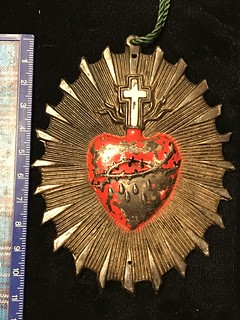
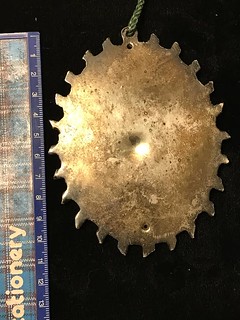
Alan V. Weinberg of Woodland Hills, CA writes:
I acquired this item in 1991 from James J Curto's estate, a 60 year collecting experience numismatist who lived in Grosse Pointe, MI and had a large US and Canadian Exonumia collection.
In my 58 years in this hobby, travelling extensively to major shows and major auctions, I've not seen another. I showed it to Harv Gamer, a good friend and once-major Calgary professional numismatist, who suggested that it may be an early Canadian Jesuit Indian Peace medal. I think he may be correct.
It is silver plated antimony (tested, but appears silver).
Center : a red-enameled (somewhat worn) high-relief heart with what appears to be rows of thorns in relief and below in relief numerous tears. Above a white enameled white cross in relief surrounded by flames in relief. Around the periphery in relief spear points or machete blades with raised rays interspersed. Integral suspension loop at top and an old cord for suspension around the neck.
Reverse blank.
Heavily toned. Quite heavy, perhaps 10 ozs.
Dimensions 110 mm x 88 mm.
I've already checked with the only living Canadian expert in Canadian early medals and IPM's that I know of - Warren Baker - and he's not seen this medal before .It may in fact not be an IPM or Canadian but it is very old, intriguingly designed for wearing and quite rare. Perhaps an E-Sylum reader can identify it?
Warren Baker writes:
It's a new one to me, and therefore can't give you any valid opinion or even speculation on it. It is indeed intriguing.
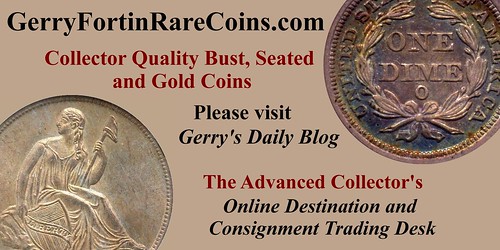
QUERY: LUCIEN COUDRAY’S ORPHEUS PLAQUE
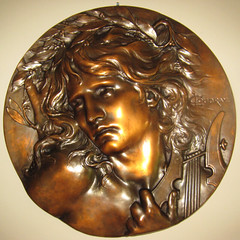
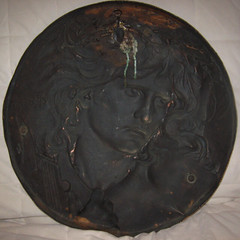
One of my long term collecting interests is the wide variety of sizes, metals, edge hallmarks, and presentation types of Lucien Coudray’s ubiquitous but beautiful Orpheus At The Gates Of Hell medallic design, first appearing at the 1900 Paris Exposition Universelle. For over a hundred years it has been one of the most popular issues of the Monnaie de Paris, and restrikes continue to be produced at the Monnaie to this day. Having recently procured what I consider to be a very unusual example, I thought your readers might be interested in seeing it and/or giving their thoughts or opinions if it is what I believe it to be. It came out of the estate of a French collector of medals.
This piece is a large, 18 inch (46 cm) diameter Orpheus obverse plaque, which was marketed as an iron or bronze cast item. It is actually a copper plaque and is relatively light in weight for it’s size at 2.25 kg. It is about 3-4 mm thick and the rim will flex a little if tested. It had 3 old attachment nuts soldered to the reverse in a haphazard triangle configuration originally, one of which is gone now, and an old time hanger was subsequently soldered on the reverse in the correct position to properly orient the Orpheus when hung on a wall.
I think this Orpheus is an early 1900’s copper galvano and it is, except for it’s larger size, a near twin to a smaller 170 mm Orpheus copper galvano in my collection. This is, however, the first Orpheus of this size that I have seen, and so I am interested in any observations the medal experts of The E-Sylum could share.
PARMELEE BIRCH CENT REDISCOVERED
Birch Cent Not Seen in 55 Years Appears in Time for Heritage Auctions ANA Platinum Night
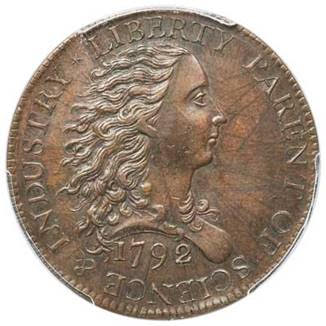 The consignment deadline for Heritage Auctions’ 2017 American Numismatic Association Auction July 31-Aug. 7 is June 21, so sellers still have a few days to submit their high-end collections
to appear along with special offerings, such as a 1792 Parmelee Birch Cent offered at auction for the first time in 55 years.
The consignment deadline for Heritage Auctions’ 2017 American Numismatic Association Auction July 31-Aug. 7 is June 21, so sellers still have a few days to submit their high-end collections
to appear along with special offerings, such as a 1792 Parmelee Birch Cent offered at auction for the first time in 55 years.
“This elusive Birch Cent has finally been found and is heading to auction,” said James Halperin, Co-founder of Heritage Auctions. “Our numismatists have spent an entire year cultivating our ANA events and we think collectors will be delighted by what they find with Heritage.”
The Birch Cent (PCGS certified and encapsulated as Genuine – Edge Filed, Denticles Repaired – XF Details) is the Plain Edge example offered at the Lorin G. Parmelee Collection auction in 1890, during which was noted the coin’s strong, sharp impression, paired with a curiously filed-down plain edge. The traditional history of the Parmelee coin has it going to DeWitt Smith-Virgil Brand-Dr. Judd.
The weight of the coin is 262.2 grains, very close to the 264 grain standard of the Mint Act of 1792. If filed down, the missing weight would make it a Judd-5, changing the census of known specimens to one Judd-3, seven Judd-4s, and three Judd-5s.
“The Parmelee provenance is very exciting,” Halperin said. “We’re delighted this specimen will be offered during ANA – a special event suitable for a special coin.”
To read the 1890 Parmelee catalog, see:
Parmelee Collection of American Coins
(https://archive.org/stream/parmaleecollection1890chap#page/n117/mode/2up)
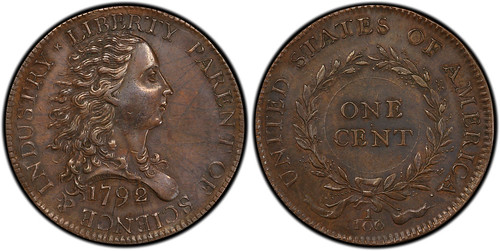
To view the full image, see:
http://images.pcgs.com/CoinFacts/82472584_max.jpg
SELECTIONS FROM STACK'S BOWERS JUNE 2017 SALES
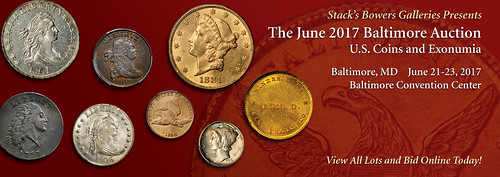
Lot 9024: Unique H. Herring of Fair Mount Token
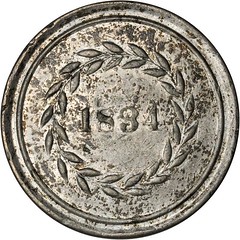
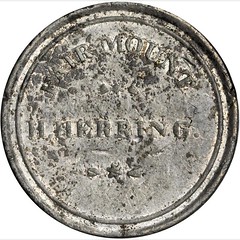
Maryland--Baltimore. 1834 H. Herring. HT-139, Low-173. Rarity-9. White Metal. Plain Edge. 35 mm. VF-20. Unique! This token is a landmark among Hard Times issues-one of the most famous and one of only a few with this status! Over a long period of decades, great collections have been formed and dispersed without having an example. Donald Miller, Stephen L. Tanenbaum, Donald Partrick, and other great collectors in the series never had a chance to own this. The term "once in a lifetime opportunity" has its very definition here!
To quote from Lyman Low, the master of the Hard Times token series, who wrote this in 1906 in the supplement to his Hard Times Tokens book:
"...this token first came to my notice about four years ago, and from the best investigation I have been able to make it was unknown to collectors until then; I have never learned of its duplicate. Not withstanding the fact that collectors of store-cards and tokens have been always with us, and the work in their special lines has been unceasing, this interesting piece seems to have evaded their watchful eyes. When we remember that such cabinets as those of Messrs. Groh, Levick, Geo. B. Mason, Benjamin Betts, Benjamin Tilton, Dr. James, Dr. Wright and others, contained many precious cards, the record prices of which in various sales show that they have brought from $10 to $50, it is remarkable that this piece should have escaped the notice of them all for nearly seventy years.
The indefatigable labor and zeal of Mr. Duffield has traced this token to Baltimore, though at first light it was his opinion, shared by Dr. Wright and myself, that it originated in Philadelphia.
"Mr. Henning (sic) was the proprietor of a hotel, promenade and pleasure ground at Fair Mount which he appears to have given the name. Its site was formerly known as Hampstead Hill, in the eastern part of the city of Baltimore. His advertisement appears in the Baltimore American and Commercial Advertiser in May, 1834, when he announced he was erecting at great expense, a large and elegant House etc. The resort was subsequently known as Fair Mount Gardens. His name is found in the Baltimore Directories from 1834 to 1835. Just what purpose this piece served, it is very difficult to assert at this remote time, but the fact that it is dated would lead one to believe it was used in some detail of his conduct of the place, during the first year of its existence, and not as an advertising venture."
To read the complete lot description, see:
Maryland--Baltimore. 1834 H. Herring. HT-139, Low-173. Rarity-9. White Metal. Plain Edge. 35 mm.
(https://auctions.stacksbowers.com/lots/view/3-7KK1G)
Lot 950: The Earliest American Dollar-Denominated Token

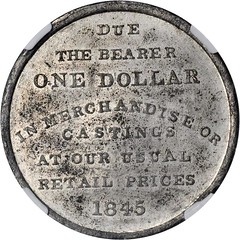
Extremely Rare Johnson Himrod & Co. $1.00 Token
The Earliest American Dollar-Denominated Token
Pennsylvania--Erie. 1845 Johnson Himrod & Co. Miller-Pa 3. White Metal. 38 mm. MS-61 (NGC).
This is an extreme rarity with an important place in the history of American tokens as the very first token ever struck with a one dollar denomination. An Extremely Fine specimen in our (Stack's) Dice-Hicks sale realized $8,050. Known only in white metal, the "copper-plated white metal" piece illustrated in Rulau is an electrotype. This ranks among the finest known.
The collecting of early tokens and medals has become a very dynamic part of numismatics in recent years. In the early 20th century various issues were very popular -- much more so than, for example, collecting Morgan dollars by date and mint. Starting in a large way in the 1930s with popular albums and pages available from Wayte Raymond and Whitman, date and mintmark collecting came to the fore. Today, this remains the focus of nearly all collectors -- well over a million who are serious and millions more who are casual in their interest. It could not be otherwise, for among early tokens and medals there are not enough in existence to satisfy a large demand. For the typical "common" Hard Times token, Civil War token, or other early American store card, often the population is fewer than 100 pieces.
To read the complete lot description, see:
Pennsylvania--Erie. 1845 Johnson Himrod & Co. Miller-Pa 3. White Metal. 38 mm.
(https://auctions.stacksbowers.com/lots/view/3-7KN07)
Lot 9111: Martin Ibert Civil War Token
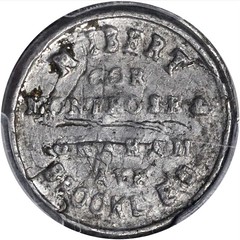
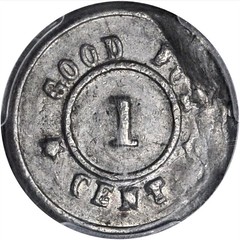
New York--Brooklyn. Undated (1861-1865) Martin Ibert. Fuld-095C-1g. Rarity-9. Lead. Plain Edge. 19 mm. EF Details--Planchet Flaw (PCGS).
This is a major rarity in this series as there are only two known examples of Fuld-95C-1g, the only type attributed to this merchant. At the time Brooklyn was a separate city, but today it is incorporated as a borough of New York City. Collecting NYC and related tokens has long been a specialty, with Wayte Raymond, for one, spending years building his holdings.
Martin Ibert was born in Baden, Germany in 1861, emigrating from that country to the United States in 1847 with his brother Albert. He became a clerk in Henry Zimmer's store in Brooklyn, and then worked for A. Saul before opening his own business dealing in flour at the corner of Leonard Street and Montrose Avenue. He later moved his business to Montrose and Graham avenues, as depicted on this token, and in 1889 left the flour business to start a brewing company.
This is the plate token for the obverse die in the third edition of U.S. Civil War Store Cards, the research and graphics triumph of the Civil War Token Society.
To read the complete lot description, see:
New York--Brooklyn. Undated (1861-1865) Martin Ibert. Fuld-095C-1g. Rarity-9. Lead. Plain Edge. 19 mm
(https://auctions.stacksbowers.com/lots/view/3-7KMKH)
Lot 9116: 1863 Atlantic Garden Token
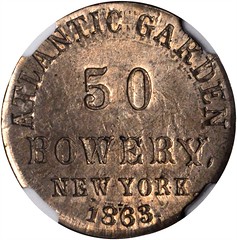
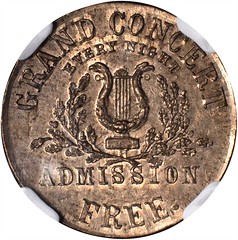
Fuld NY-630A-1do Atlantic Garden
Overstruck on an 1859 Indian Cent
New York--New York. 1863 Atlantic Garden. Fuld-630A-1do. Rarity-9. Copper-Nickel. Plain Edge. 20 mm--Overstruck on an 1859 Indian Cent--MS-65 (NGC).
The Bowery in lower Manhattan was the center for culture-high as in theaters, low as in gambling dens and ladies of the night. Somewhere in between was the vast Atlantic Garden beer hall at 150 Bowery, memorialized on Civil War tokens and famous for two huge orchestrions or automatic orchestras-the first installed in the 1860s and its successor brought after being a sensation at the World's Columbian Exposition in 1893. The history of the Atlantic Garden is well documented by Henry B. Dawson (see Historical Magazine, July 1867) and Edgar H. Adams (see The Numismatist, September 1911). Dave Bowers has also written extensively about this unique establishment. Edgar Adams said in part:
"Atlantic Garden, one of the oldest of New York's amusement places, is to be torn down this month. For over half a century it has been conducted as a German family resort, where one could enjoy good music and, incidentally, good beer, and other refreshments. Here held forth a famous lady orchestra which many New Yorkers and out-of-town visitors well remember. The Garden was built on the site of the Bull's Head Tavern, which for a time served as Washington's headquarters during Revolutionary days."
To read the complete lot description, see:
New York--New York. 1863 Atlantic Garden. Fuld-630A-1do. Rarity-9. Copper-Nickel. Plain Edge. 20 mm--Overstruck on an 1859 Indian
Cent--.. (https://auctions.stacksbowers.com/lots/view/3-7KKUP)
Lot 11606: 1872 Pattern Amazonian Eagle
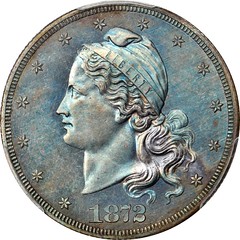
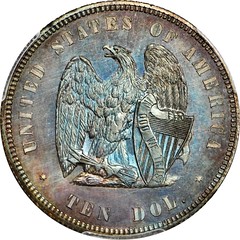
Fabled 1872 Pattern Amazonian Eagle
Judd-1246 in Copper
1872 Pattern Amazonian Eagle. Judd-1246, Pollock-1388. Rarity-7-. Copper. Reeded Edge. Proof-64 BN (PCGS). CAC.
Obv: William Barber's celebrated Amazonian design with a bust of Liberty facing left, 13 stars around the border, and the date 1872 below. Liberty is wearing a Phrygian cap inscribed LIBERTY.
Rev: An eagle with spread wings clutches a group of three arrows in its right talon and supports a shield with its left talon. A scroll crossing the shield is inscribed with the motto IN GOD WE TRUST. The legend UNITED STATES OF AMERICA is above and the denomination TEN DOL. is below. This beautiful near-Gem is vividly toned in a blend of steel-blue and copper-rose colors. Fully struck in all but a couple of isolated areas, both sides are smooth and attractive with a lively satin to semi-reflective finish. This is one of the most famous and eagerly sought designs among U.S. pattern coinage.
To read the complete lot description, see:
1872 Pattern Amazonian Eagle. Judd-1246, Pollock-1388. Rarity-7-. Copper. Reeded Edge. Proof-64 BN (PCGS). CAC
(https://auctions.stacksbowers.com/lots/view/3-7KRZP)
Lot 11614: Miners' Bank $10 Gold
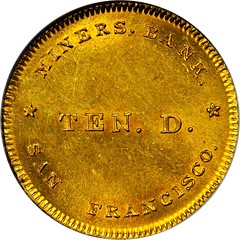
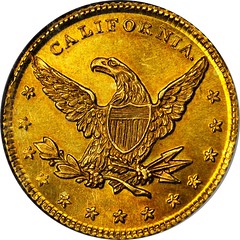
Undated (1849) Miners' Bank $10 Gold. K-1. Rarity-6. Copper Alloy, Plain Border. MS-65 (NGC).
The firm of Wright & Co., exchange brokers, was located at the corner of Washington and Kearny streets, Portsmouth Square, San Francisco, early in September 1849. On August 7 the firm requested permission from local authorities to coin $5 and $10 gold coins, declaring they would be worth as much as Federal issues. Authorization was not granted. In November, Wright & Co. reorganized. Composing the new company were Stephen A. Wright, John Thompson, Samuel W. Haight, and J.C.L. Wadsworth. Known as the Miners' Bank (or Miners/Miner's-punctuation varied), the outfit was housed in a wooden frame structure for which the incredible sum of $75,000 rent per year was paid.
It is believed that the $10 coins were produced in the autumn, apparently before the November 1849 reorganization was completed, for William P. Hoit, assayer of the New Orleans Mint, reported on December 13, 1849, that he had assayed a Miners' Bank $10 nearly two months earlier, and that he had found it to be worth only $9.65. Alta California reported this on April 11, 1850: "The issue of the Miners' Bank is a drug on the market. Brokers refuse to touch it at less than 20 percent discount.…" On December 14, 1850, the Miners Bank dissolved. As the Miners Bank $10 pieces no longer circulated at par, the pieces in the hands of the public went to bullion dealers at a discount and were melted. Within a few years they were rare.
Provenance: From Numismatic Gallery's (Abe Kosoff and Abner Kreisberg) sale of the "Memorable Collection" (i.e., J.F. Shapiro, a.k.a. J.F. Bell), March 1948, lot 968; RARCOA's session of Auction '82, August 1982, lot 989; our (Stack's) sale of the Archangel Collection, November 2006, lot 1076.
To read the complete lot description, see:
Miners' Bank $10 Gold (https://auctions.stacksbowers.com/lots/view/3-7KRFL)
Lot 11624: 1860 Mormon $5 Uniface Obverse Restrike
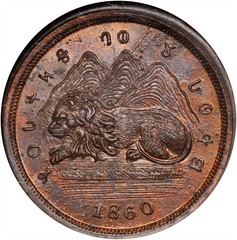
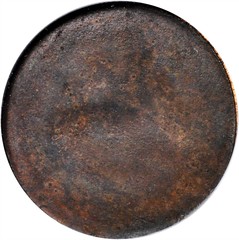
1860 Mormon $5. Uniface Obverse Restrike. K-8. Rarity-7. Copper. Plain Edge. MS-64 RB (NGC).
Abundant mint red luster glows amid brown, speck-free surfaces on this near Gem survivor of the unused die of 1860 Mormon $5s. The actual die that struck the 1860 issues in gold had only a larger and more upright reclining lion, whereas this obverse die features the nearly fully reclining lion at the foot of a trio of stylized mountain peaks, undoubtedly representing Salt Lake City at the foot of the Rocky Mountains. It is thought that this and the other uniface Mormon restrikes in copper were made circa 1898 for promotional use during the commemoration of the 50th anniversary of the Mormons' arrival in what became Salt Lake City. This particular pattern is popular not only for its unused design, but also for its use of the short-lived Deseret alphabet to deliver a phonetic rendering of the phrase "Holiness to the Lord". This "restrike" has it all-high quality, rarity, pedigree, a charming unadopted design, and the rare numismatic usage of the Deseret alphabet.
Provenance: From Kagin's circa 2008 Fixed Price List of the Robert Bass Collection of Pioneer Patterns, lot 128.
To read the complete lot description, see:
1860 Mormon $5. Uniface Obverse Restrike. K-8. Rarity-7. Copper. Plain Edge.
(https://auctions.stacksbowers.com/lots/view/3-7KRB0)
Lot 11632: Confederate Half Dollar Scott Restrike
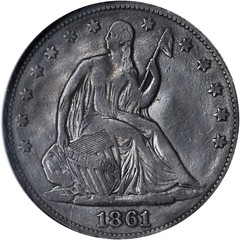
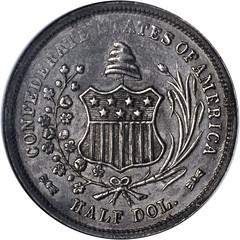
"1861" (1879) Confederate Half Dollar. Scott Restrike. Breen-8002. AU-55 (NGC).
A richly toned steel gray example with sharp detail to much of the reverse design. Seized by Louisiana when that state seceded from the Union in 1861, the New Orleans Mint eventually passed under the control of the Confederate States of America. After that happened, Southern authorities made an attempt at coinage that displayed a design distinct to the new Confederacy. Accordingly, four half dollars were struck combining the familiar Liberty Seated motif of Union coinage with a new reverse design that includes, among other elements, the legend CONFEDERATE STATES OF AMERICA. All four of these coins, as well as the reverse die, were retained by Chief Coiner of the New Orleans Mint Dr. B.F. Taylor. The die was eventually obtained by E.B. Mason, Jr. of Philadelphia in 1879 and sold to John Walter Scott. Scott and his partner decided to profit from their ownership of the original CSA reverse die by striking and selling a small number of restrikes of the very rare 1861 Confederate half dollar.
In order to test the die and determine its suitability for coinage, Scott at first struck 500 tokens using a new obverse die the inscriptions of which provide some information about the original 1861 CSA halves. He then proceeded to prepare the actual restrikes. To do so Scott obtained 500 original 1861-O Liberty Seated half dollars, "drilled off" their reverses and restruck that side using the Confederate reverse die. This process caused more-or-less loss of detail to the obverse design, as evident on the present example.
To read the complete lot description, see:
"1861" (1879) Confederate Half Dollar. Scott Restrike. Breen-8002.
(https://auctions.stacksbowers.com/lots/view/3-7KTLI)
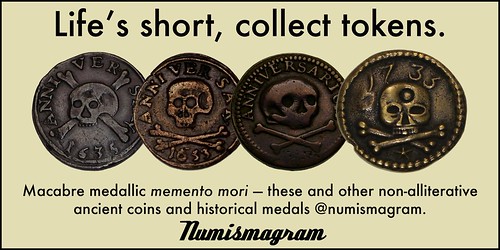
NUMISMATIC NUGGETS: JUNE 18, 2017
1906 French Chien de Berger Medal
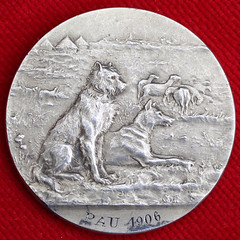
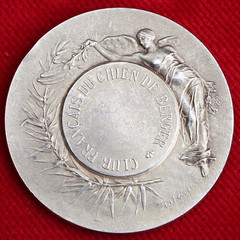
1 medal from the Sheepdog French Club - SILVER hallmark on the edge. Diameter: 45 mm Pau 1906
To read the complete lot description, see:
58. France - lot of 2 medals 'Cyclisme 1894' & 'Chien de Berger
1906' – silver (https://auction.catawiki.com/kavels/12245719-france-lot-of-2-medals-cyclisme-1894-chien-de-berger-1906-silver)
1915 Cuba 20 Pesos
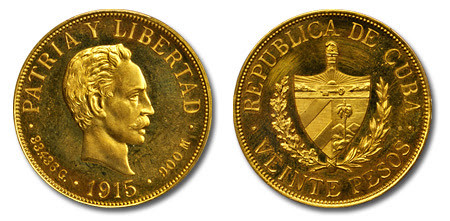
This week’s highlight from our August 2017 Official Auction at the ANA World's Fair of Money in Denver, Colorado is a rare low mintage 1915 Cuban Proof 20 Pesos. This is a two-year type produced only in 1915 and 1916. Prior to the issuance of Cuba’s first national coinage foreign coins circulated freely and exchange rates fluctuated daily. On June 12, 1906, a banking commission was set up to regulate the currencies then in circulation and to consider a national coinage. This was met with opposition that finally led to the National Economic Defense Law of October 29, 1914, which outlined the weight, fineness and measurements of the specified denominations, but not their actual designs.
Since there had never been a mint in Havana, the U.S. Mint at Philadelphia was given the contract, with Mr. Montoulieu as inspector on behalf of the Cuban government. Bids to design this new coinage were invited, with the contract finally awarded to Mr. Charles E. Barber of the Philadelphia Mint. His design and craftsmanship was of the highest quality; some would consider his work far superior to that of his contemporaries from the same source. The 20 Pesos were set to the same standard as United States $20 gold coins of the time. The obverse depicts the bust of Patriot Jose Marti right, date below flanked by the weight of 33.436G (20 times the weight of the gold 1 peso) and the purity 900M (900 fine). The reverse depicts the arms of the republic of Cuba surrounded by an oak and laurel wreath superimposed on a Fasces surmounted by a Phrygian cap, legend around.
The actual mintage figures for the 20 Peso Proofs are unknown. Mr. Thomas Lismore in his pamphlet “The Coinage of Cuba 1870 to Date” (1966) speculates that perhaps 20 to 30 were struck for inclusion in sets, but since the mintage figures include the Proofs it is impossible to determine the actual number struck. Mr. Lismore goes on to say that many of the Proofs that he examined prior to his publication were not very well kept and “are no longer proof quality.” Needless to say the example we are offering is a well preserved specimen sure to excite even the most sophisticated of Cuban numismatists.
To read the complete article, see:
Rare and Desirable Cuban Proof 20 Pesos (http://www.stacksbowers.com/News/Pages/Blogs.aspx?ArticleID=2561)
WWI Belgian Yser Battle Medal
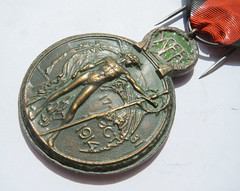 This medal was instituted on 18-10-1918 and was awarded to Belgian and allied soldiers that fought between October 17 and 31, 1914 and were part of the army that fought by the river the
IJzer/Yser and were able to stop the German advance.
This medal was instituted on 18-10-1918 and was awarded to Belgian and allied soldiers that fought between October 17 and 31, 1914 and were part of the army that fought by the river the
IJzer/Yser and were able to stop the German advance.
The medal is made of bronze with a beautiful patina covering the medal. On top of the medal it says the word "Yser" in a green enamel field, on the back the monogram "A", representing King Albert.
On the front of the medal we see a man with a lance, who symbolises the Belgian soldier who brought the German army to a standstill. The reverse shows the battlefield with a wounded (Belgian) lion and the word Yser again.
The ribbon is red with black borders, which symbolises blood and death, the battle of the Yser was a bloody battle in which 60,000 Belgian soldiers died which amounted to more than 1/3 of the total Belgian army. The medal is held in very high esteem.
To read the complete lot description, see:
50. Yser medal in memory of service in the "battle of the Yser" -
WW1. (https://auction.catawiki.com/kavels/12192537-yser-medal-in-memory-of-service-in-the-battle-of-the-yser-ww1)
1930s Medal by Henry Dubois
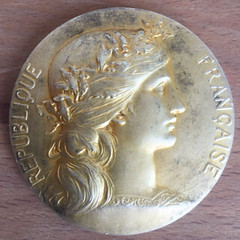
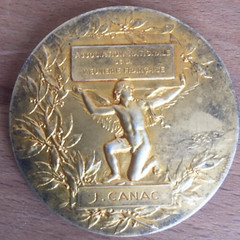
Henri Dubois - 1st content silver medal Republique Française. Association nationale de la meunerie Francaise
A beautiful Silver Medal with the design by Henri Dubois. Very detailed
On the side of the coin it says 1argent meaning the highest silver content. Namely 95%.
The coin weighs 64 grams and has a diameter of 5 cm. Supposedly made in France around 1930.
To read the complete lot description, see:
12. Henri Dubois - 1st content silver medal Republique Française
(https://auction.catawiki.com/kavels/12271477-henri-dubois-1st-content-silver-medal-republique-francaise)
1965 Churchill Memorial Medal
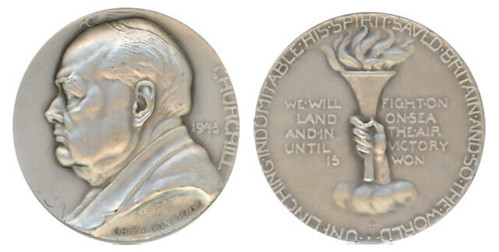
CHURCHILL MEMORIAL MEDAL, 1965. Engstrom 35C. 50mm. .958 Silver. (2.47 oz.)A. Lowenthal, Sc. (John Pinches). Unc. Obv Bust of WS left, CHURCHILL 1945 to the right. Below: OB.24.JAN. 1965. Rx: At center, a hand rises above a cloud holding a flaming torch. WE WILL FIGHT ON/ LAND ON SEA/ AND IN THE AIR/ UNTIL VICTORY/ IS WON to either side of the torch. The surrounding legend reads: UNFLINCHING INDOMITABLE HIS SPIRIT SAVED BRITAIN AND SO THE WORLD.
This is a reissue of the 1945 Lowenthal medal in reduced size and with the addition of the date of death.

WAYNE'S NUMISMATIC DIARY: JUNE 18, 2017
If you're wondering why last week's issue didn't hit your inbox until the wee hours of Monday morning, nothing bad happened. In fact, it was due to a very good occasion in our household - our oldest son Christopher graduated from high school, and several out-of-town relatives were on hand for a party and the commencement ceremony. I needed to work late Sunday to complete the week's issue.
Some of you are reading The E-Sylum for the first time today, but we've been publishing weekly since September 4, 1998, when I started the email newsletter to promote the Numismatic Bibliomania Society. From our web site:
The Numismatic Bibliomania Society (NBS) is an educational organization founded in 1979 to support and promote the use and collecting of numismatic literature. Numismatic literature includes books, periodicals, catalogs and other written or printed material relating to coins, medals, tokens, or paper money, ancient or modern, U.S. or worldwide.
Email and the Internet were new to most people then, and I'd had to wait a couple years from my initial idea until enough NBS members even had email addresses. But by 1998 the time was finally ripe, and I had an additional personal reason to start the newsletter - I had a pregnant wife and my days of going to coin shows and club meetings whenever I wanted were behind me. The Internet would allow me to stay in touch with my friends and hobby from the comfort of my home office.
Right on schedule our son arrived December 18, 1998 as reported in Volume 1, Number 12. Now 'the kid' is bigger and taller than me, and heading to college in the fall.
The E-Sylum has grown a bit, too. From an article or two per week and 88 subscribers, we now have as many as 40 articles and over 3,000 subscribers.
Nummis Nova
I saw a need for a numismatic email newsletter, and since it didn't exist, I created it. And when I moved my family to Northern Virginia I didn't find any close-by clubs of the sort I'd
enjoyed in Pittsburgh. So I started one. Our kids were older by then, and it would be my one night out with friends.
I modeled it after The Sphinx Society, started by Ray Byrne in 1960. The group has no Constitution, no officers, no committee and no reading of the minutes. It's a pure social group, meeting monthly for a dinner and numismatic fellowship. Here's a report from our latest meeting.
After work Tuesday June 13 I made my way to The Esposito's Italian restaurant in Fairfax, VA. I was the first to arrive, but was soon joined by Eric Schena, Dave Schenkman, Gene Brandenburg, Ron Abler and Wayne Herndon. Before long Joe Esposito, Steve Bishop, Mike Packard and Roger Burdette were there as well. We sat at a long rectangular table toward the back.
I was dead tired from the long weekend, but happy to see everyone. I didn't bring anything to show, but others did. Eric Schena showed us copies of a manuscript he'd written in college on early Russian coinage.
Thomas Paine "End of Pain" Conder Token
Steve Bishop had a nice "End of Pain" token, a Russian copper, and some nice silver dollars. He provided these photos, but the one of the 1884-CC doesn't do it justice - it's a
great-looking coin. The other dollars had some interesting toning patterns from contact with other coins or objects.
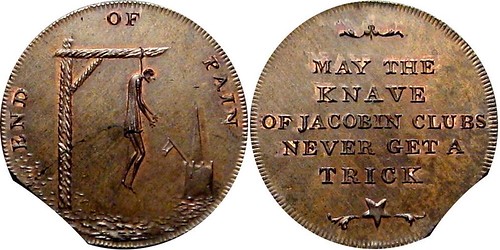
The piece refers to Thomas Paine, the British-born revolutionary gadfly whose pamphlet Common Sense was enormously influential in the American colonies. It's not a favorable piece, showing a corpse hanging from a scaffold with the inscrition "END OF PAIN". The reverse reads "May the knave of Jacobin clubs never get a trick." It is one of several varieties of anti-Paine Conder tokens. Joe Esposito identified it for me as Dalton & Hamer Middlesex 1105.
The piece was discussed on the NGC chat boards. Participant Conder101 wrote:
While Paine was very popular here before and during the Revolution, afterward he became an annoyance and he had to leave and go to England. He had a similar effect in England where his writings were pro-French revolution. This made him very unpopular with the Royalists (Hence the desire for the "End of Pain".) Eventually he had to flee England for France. He was well received there.....at first. But eventually his writing critical of what the revolution was becoming forced him to flee again. This time back to England. He always managed to annoy the people in power where ever he went.
The Jacobin Club was the Society of the Friends of the Constitution, a group of pro-French Revolution political activists. Knave referred to Paine kind of like a spokesman for the Jacobins. May he never get a trick, may he not be successful in his endeavors.
To read the complete article, see:
Middlesex hanging man (https://www.ngccoin.com/boards/topic/328650-middlesex-hanging-man/)
U.S. Silver Dollars
Here are the silver dollars.
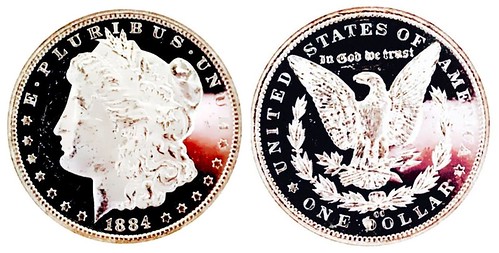
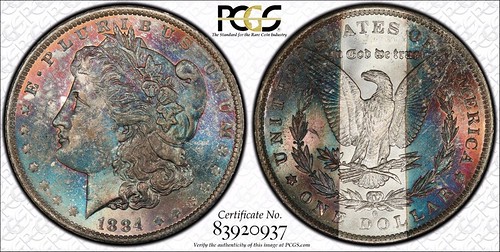
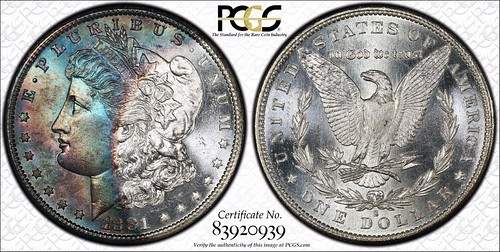
Neat and Gas Boxing Match Token
Dave Schenkman showed a great boxing medal he'd picked up on eBay.
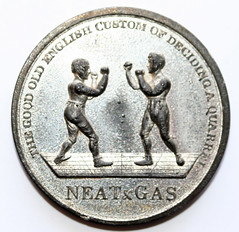
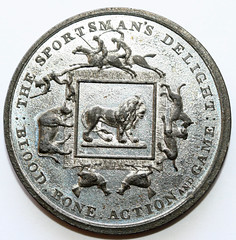
Dave writes:
This rare medal was struck to celebrate a fight which took place on December 11, 1821 between Thomas "gas-light man" (so nicknamed because his day job was lighting gas lamps) Hickman of London and the winner, William Neat, of Bristol. white metal, 41mm
Great piece. I'd never seen it before. It was an enjoyable evening. The place was thoroughly Italian with the menu in Italian as well. I ordered a salmon dish and it was wonderful.
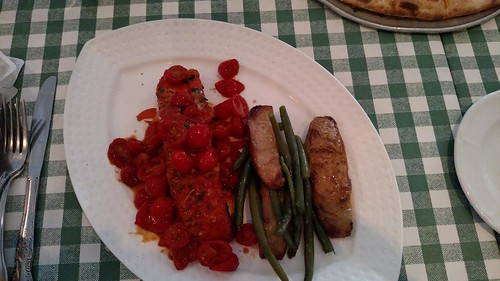

Mike Packard and Wayne Herndon
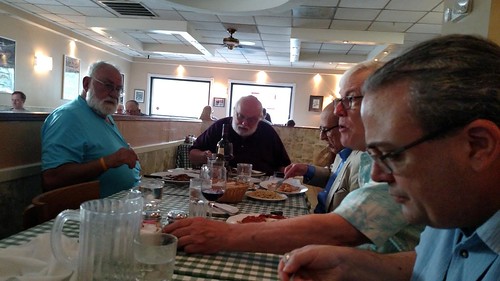
From left, clockwise: Ron Abler, Gene Brandenburg, Joe Esposito, Dave Schenkman and Eric Schena.
I ended up having a long conversation with Roger Burdette about how different people percieve and handle money, and about the structural problems of the health care industry in the U.S. So it's not always about numismatics, but always interesting conversation.
I was so engrossed I didn't get up to mingle at the other end of the table as usual. Upon leaving some kidded, "See you - it was nice not talking to you!" That's the one thing I dislike about our meetings - restaurants park us at long tables and it's difficult to see or talk with all of the attendees. Still, it was a great night of fellowship as always.
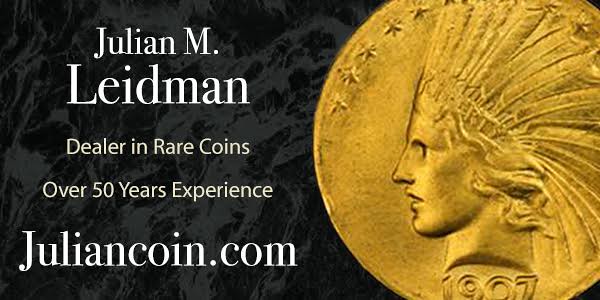
THE GOLD HOARD OF LIENDEN
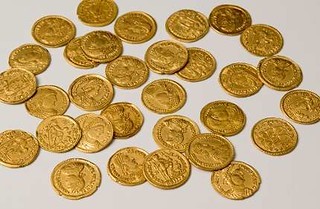 Archaeologists of VU Amsterdam and the Cultural Heritage Agency of the Netherlands unveiled a fascinating hoard of gold coins in Het Valkhof Museum in Nijmegen last week. The treasure must
have been buried around AD 460, not long before the final fall of the West Roman Empire in 476. 'The find adds a key element to our knowledge of the final stages of Roman rule in the Netherlands
and the transition to the Early Middle Ages', said archaeologist Nico Roymans.
Archaeologists of VU Amsterdam and the Cultural Heritage Agency of the Netherlands unveiled a fascinating hoard of gold coins in Het Valkhof Museum in Nijmegen last week. The treasure must
have been buried around AD 460, not long before the final fall of the West Roman Empire in 476. 'The find adds a key element to our knowledge of the final stages of Roman rule in the Netherlands
and the transition to the Early Middle Ages', said archaeologist Nico Roymans.
In the summer of 2016, treasure hunters ('amateur archaeologists') found 23 Roman gold coins in an orchard in Lienden in the Dutch province of Gelderland. After reporting it through PAN, the archaeologists tracked down two other treasure hunters who had found eight gold coins in exactly the same spot four years earlier. Archival research revealed that similar coins – which had vanished in the meantime – had been found on the same plot of land in the 19th century. The coins are solidi, the standard Roman gold coin dating from the late 4th and 5th century.
'The Lienden gold hoard is very special for two reasons,' Roymans explains. 'It is the largest currently known hoard of solidi in the Netherlands. It also appears to be the very last Roman hoard of coins we know of in the Netherlands and adjoining regions. The latest of the coins bears the likeness of Emperor Majorian, who ruled from 457 to 461. This implies that the treasure must have been buried sometime around 460 or shortly after. The West Roman Empire ended in 476 when the last Emperor was deposed.
The gold hoard of Lienden is a unique document of historical interest for the last stages of Roman rule in the Netherlands, giving us an insight into the political and military situation during the transitional phase to the Early Middle Ages. It is the last hoard of Roman gold in the Netherlands, which marks the end of the West Roman Empire in this country.
To read the complete article, see:
Unique hoard of gold casts new light on final stages of Roman rule in the Netherlands
(https://phys.org/news/2017-06-unique-hoard-gold-stages-roman.html)
ANCIENT COINS AND HOLLYWOOD'S HISTORIC BLUNDERS
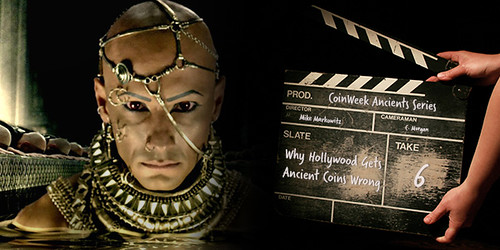
I have endured what no one on earth has endured before. I kissed the hands of the man who killed my son. I loved my boy from the moment he opened his eyes until the moment you closed them. Let me wash his body. Let me say the prayers. Let me place two coins on his eyes for the boatman.
In the epic film Troy (2004) which cost US$175 million to make, the great Peter O’Toole in the role of King Priam, speaks these words as a supplicant to Brad Pitt (Achilles), who has killed and mutilated Priam’s son Hector, played by Eric Bana. In ancient Greek religion, this kind of supplication was a powerful ritual, under the special protection of the gods.
But Priam cannot place two coins on the eyes of his son, because coins don’t exist in his world; they will not be invented for centuries.
Ancient sources gave dates for the Trojan War, ranging from 1334 to 1135 BCE. Current scholarly consensus puts the most likely date around 1180 BCE. The poet Homer, composer of the Iliad (our main literary source for the Trojan War), lived about 850 BCE. He never saw a coin. Warriors in the time of the Trojan War might be buried or cremated with a mask of gold foil, but not with coins or coin-like amulets.
Why?
The depiction of coinage in films and TV series about the ancient world is almost always wrong. This is a source of endless irritation to classical numismatists but it is understandable.
Ancient weapons, costumes, and interiors seen in films are generally accurate (though sometimes exaggerated for effect) because production designers and prop masters care about getting these things right, and the professors of classics, art history or archaeology typically engaged as consultants know these subjects well. But coins are small, and they seldom appear on screen in close-up or for any length of time. The study of ancient coins is specialized, technical and rarely of much interest to the audience (with the possible exception of Biblical films, which is a topic for another article).
But if any future gladiator epics need a numismatic consultant, Hollywood directors should know that I’m available.
To read the complete article, see:
Why Hollywood Gets Ancient Coins Wrong
(https://www.coinweek.com/ancient-coins/why-hollywood-gets-ancient-coins-wrong/)

IMITATIONS OF ALFRED THE GREAT SILVER PENNIES
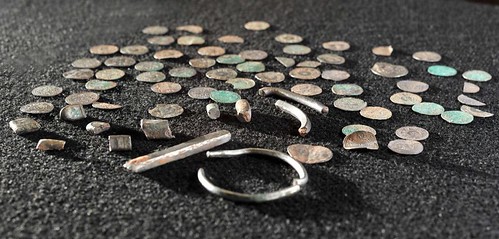
IN times of political upheaval people seek the reassurance of the familiar - especially when it comes to money.
We get endless TV and press coverage of the effect of Brexit on the relative value of the pound - which is serious stuff as our modern currency is only paper and has no real value.
In the late 9th century when the Anglo-Saxons were fighting the Vikings - and largely losing to them - even the Scandinavian invaders were conscious of maintaining the value of what was then a silver-based economy.
Evidence of this reliance on cut pieces of silver bullion and coins was provided a few years ago by spectacular later Viking finds at Furness and Silverdale.
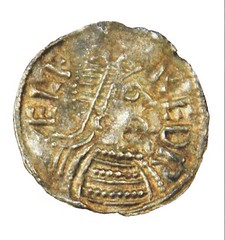 By the 880s the Vikings had taken over the territory of all but the West Saxons but they provided their subjugated peoples with money they knew - in the form of imitations of the silver
pennies produced by Alfred the Great.
By the 880s the Vikings had taken over the territory of all but the West Saxons but they provided their subjugated peoples with money they knew - in the form of imitations of the silver
pennies produced by Alfred the Great.
Their production was described by William Mackay at a Harrogate conference held by the British Association of Numismatic Societies.
He said: "The imitations were designed to circulate and were often well produced."
They were accepted as there was still a need for coinage in the Viking controlled areas of the Midlands, often termed the Danelaw.
The likely dates for the imitations are between 880 and 885 and hoards of them have been found in Cumbria, Lancashire and Yorkshire.
To read the complete article, see:
Vikings knew how to maintain trust in their money
(http://www.nwemail.co.uk/Vikings-knew-how-to-maintain-trust-in-their-money-20c29a1a-095f-4491-8bdf-bd50a06f8075-ds)
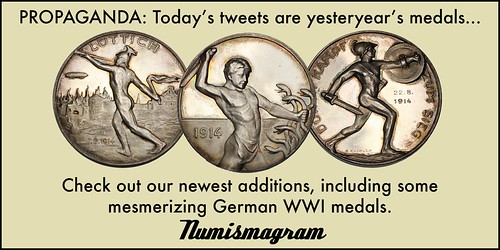
KüNKER VIDEO: SHIPS ON COINS
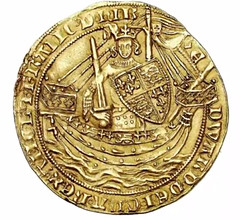
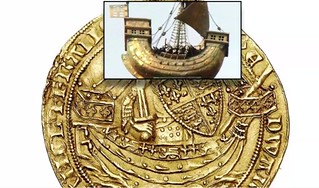
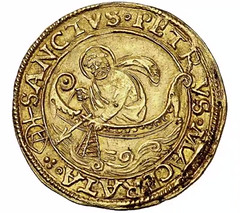
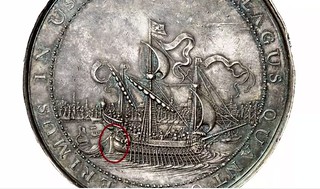
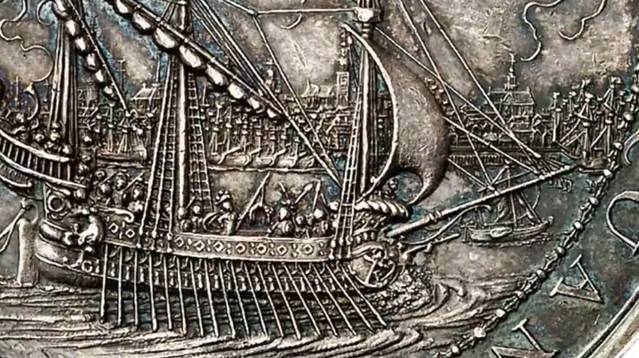
To watch the complete video, see:
Künker Summer Auction Sale 293-294 (https://www.youtube.com/watch?v=KqTkps4BpgU)
THE ARMY-NAVY E (ANE) MEDAL
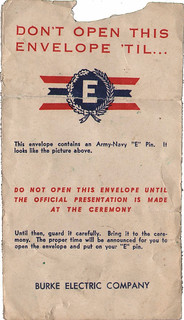 I am not certain when I started collecting Army-Navy E (ANE) award stuff. Sure, it is all great World War II material and often you find emblems for the ANE stuff included in war bond
advertising. Since I avidly collect the bonds, it is probably this connection that got me started. I do not often mention this little specialty of mine here in the Gram because of the requirement for
numismatic content and there is not really much of that associated with the ANE award program.
I am not certain when I started collecting Army-Navy E (ANE) award stuff. Sure, it is all great World War II material and often you find emblems for the ANE stuff included in war bond
advertising. Since I avidly collect the bonds, it is probably this connection that got me started. I do not often mention this little specialty of mine here in the Gram because of the requirement for
numismatic content and there is not really much of that associated with the ANE award program.
The most common items found are silver pins in the shape of the ANE award program emblem. Though silver and mostly struck, it is still a bit of a stretch to call them numismatic. The one real hook
is the three inch medal that was created for some (really only a very few) of the companies.
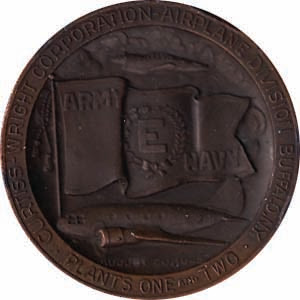 The only one of these medals that you will find is for the Curtis Wright Corporation. These medals are really common, but it has not always been that way. Before the Internet, they were
really hard to find.
The only one of these medals that you will find is for the Curtis Wright Corporation. These medals are really common, but it has not always been that way. Before the Internet, they were
really hard to find.
The first one that I found for my collection came from a grouchy dealer in aviation artifacts. At the time I was seriously collecting aviation stocks and bonds. I do not know how I found this fellow, but he put out a very interesting list and I bought a few nice certificates from him.
Then in one of his lists he had one of these Curtis Wright medals and, of course, he wanted what I considered to be a very high price for it. I agonized. Then I thought about it and agonized some more. I cannot remember all of the details, but he would not accept calls and had a bunch of other real strange policies. Of course, you know that I could not resist and I bought it. I suppose that I am happy that I did because it helped keep me interested. You also know from the way the story is going that they are much cheaper now on ebay. Yep.
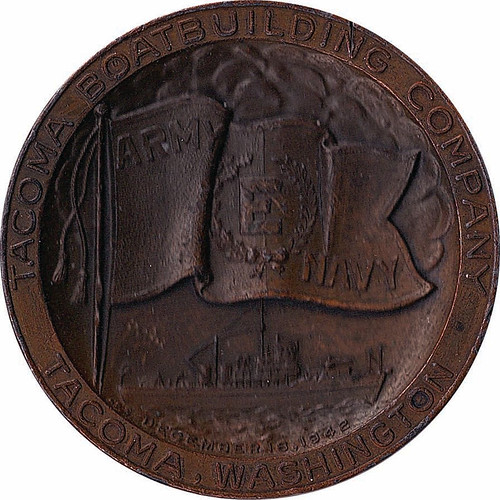 Eventually lightening struck. On ebay I found the illustrated Tacoma Boat Builders medal. It is clearly in the style of the Curtis-Wright medal. The situation with the Tacoma medal was
quite different from the Wright medal. The opposite in fact. This time the seller put it up with a very low starting price (but no buy it now). I put in a serious bid. Serious and in big. I always
say that there is no good experience like your own. I had never seen anything except the Wright medal so I wanted to own this one and I do! I am sure that my bid was to the great surprise of the
underbidder and to the delight of the seller, but it came home.
Eventually lightening struck. On ebay I found the illustrated Tacoma Boat Builders medal. It is clearly in the style of the Curtis-Wright medal. The situation with the Tacoma medal was
quite different from the Wright medal. The opposite in fact. This time the seller put it up with a very low starting price (but no buy it now). I put in a serious bid. Serious and in big. I always
say that there is no good experience like your own. I had never seen anything except the Wright medal so I wanted to own this one and I do! I am sure that my bid was to the great surprise of the
underbidder and to the delight of the seller, but it came home.
To sign up for the MPC Gram, see:
http://guide.us13.list-manage.com/subscribe?u=10eb366ab80344a56657e0d5d&id=58874b37e1
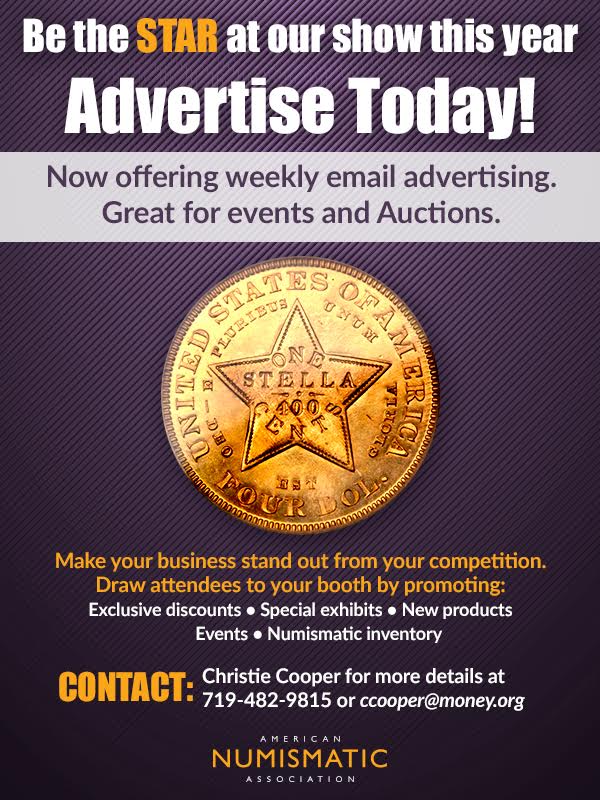
HANS SLOANE: THE MAN WHO COLLECTED THE WORLD
Collecting the World: The Life and Curiosity of Hans Sloane. By James Delbourgo. Allen Lane; 503 pages; £25. To be published in America by Belknap in July; $35.
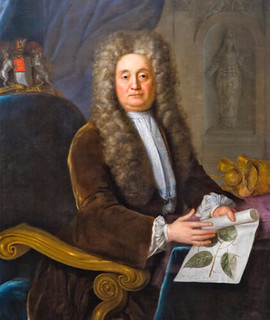 JOINED-UP words and sentences with verbs are not enough to describe Sir Hans Sloane. Only a list can do justice to this man, who was both quite remarkable and, to some, a little touched.
Over the course of a lifetime, he managed to accumulate 3,516 volumes of manuscripts, as well as books of prints, which together amounted to 50,000 volumes; 32,000 medals and coins; 5,843 testacea
and shells; 173 starfish; 12,506 vegetable substances and 55 mathematical instruments. This is just a selection from Sloane’s collection, much of which he eventually catalogued himself.
JOINED-UP words and sentences with verbs are not enough to describe Sir Hans Sloane. Only a list can do justice to this man, who was both quite remarkable and, to some, a little touched.
Over the course of a lifetime, he managed to accumulate 3,516 volumes of manuscripts, as well as books of prints, which together amounted to 50,000 volumes; 32,000 medals and coins; 5,843 testacea
and shells; 173 starfish; 12,506 vegetable substances and 55 mathematical instruments. This is just a selection from Sloane’s collection, much of which he eventually catalogued himself.
Or try this: “a set of surgeons’ instruments made from fish-skin; inks and inkhorns; face-paint; medicinal powders and pills; women’s shoes made of leather and silk; gold and silver pins and needles for the practice of acupuncture; tobacco pipes; several portable Buddhist ‘idols’; gilded rhinoceros horns; ‘metallick burning glasses’ and ‘a ball of several colours to be thrown into the fire to perfume a room’.” These are some of the objects Sloane acquired from Japan.
The Anglo-Irish physician, collector and naturalist was not a man of small ambitions. He aimed for universal knowledge, available to all humankind, with a serious play for personal immortality thrown in. He did not make such a bad fist of them: his acquisitions became the foundation of the British Museum, as well as the collections of the Natural History Museum and the British Library.
He would surely be irritated that his name endures more strongly in London’s topography than in universal understanding. There are a dozen or so Sloanes and Hanses listed in the city’s “A to Z”, because Sloane had the presence of mind to buy up most of Chelsea in the course of his long and prosperous life.
He was born in Ulster in 1660 and died at 92 with a cunning plan to leave a permanent mark on human civilisation. He had set himself up in London as a physician and made himself the undisputed king of the capital’s medicine men, attending the best bedsides for the best prices. He married money and enjoyed the revenues from vast slave-plantations in Jamaica.
Sloane was president of the Royal College of Physicians and the Royal Society but he was not exactly a man of ideas. What he liked was stuff. He was a man of the Enlightenment, but not a man remarkable for enlightened thought. An enemy called him “master of only scraps”.
In his early days Sloane spent a year in Jamaica, working as a physician just as Britain was concentrating on acquiring an empire. Prudently he stuck to water while his patients drank themselves to death on Madeira wine. This was the time when he began to get serious about collecting.
After he had accumulated his Jamaicana, he returned to London and set about collecting the rest of the world. In this he had the assistance of a large fortune, a vast network of contacts—he was reckoned to have 1,793 correspondents—and a limitless curiosity, or perhaps a limitless appetite for curious things.
Sloane sold the lot to the nation posthumously, for £20,000 (worth about £4m, or $5.2m, now), which he reckoned was a quarter of its value, to be paid to his two daughters. Had the nation turned down this offer, his executors had instructions to offer the stuff to St Petersburg.
He was a curious man in every sense. His biographer has struggled with a shortage of anecdotal and humanising material. That gives “Collecting the World” a somewhat static feel, like a cabinet of curiosities. Little of Sloane’s stuff remains on display in London, though there is still a store of his Jamaican specimens in the Sir Hans Sloane herbarium at the Natural History Museum. It is a reminder of that great tradition of learning, based around museums and libraries and emblematic of what the British Museum would come to describe as being, “for the benefit of all studious and curious persons, native and foreign”.
To read the complete article, see:
The life and curiosity of Sir Hans Sloane
(http://www.economist.com/news/books-and-arts/21723086-new-biography-founder-british-museum-natural-history-museum-and)
SHENG QI’S PAINTINGS OF MONEY
Chinese artist Sheng Qi 盛奇 currently has his first solo show at the GX Gallery in London. Many thanks to Joe Cribb for drawing this to our attention and sending the four photos below!
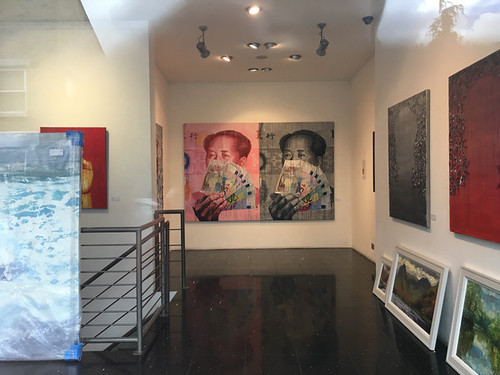
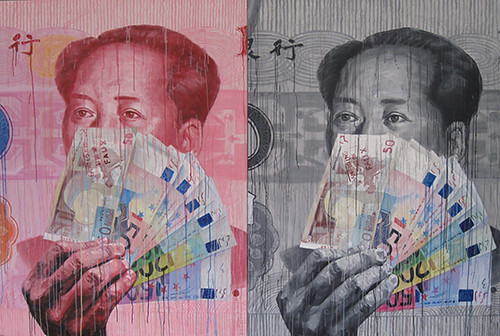

To read the complete article, see:
SHENG QI’S PAINTINGS OF MONEY
(https://chinesemoneymatters.wordpress.com/2017/06/16/sheng-qis-paintings-of-money/)
To visit the artist's web site, see:
http://www.sheng-qi.com/
VOCABULARY TERM: CUPROLAMINOPHOBIA
Ken Spindler of San Diego writes:
To justify turning down my invitation to sit with me at the coin clubs' information table at the San Diego County Fair on July 4, a non-numismatic friend just claimed he has this "condition" and it prevents him from accepting. I think everyone in my family except me must have it. Maybe you have family members who suffer from it, too. I guess it's contagious. Luckily, I must be immune.
Cuprolaminophobia is the fear of coins. Since coins are made of metal, sufferers of metallophobia would readily suffer cuprolaminophobia too. Since many coins are used for money, this fear may lead to chrometophobia, but not readily. Since some coins are used as religious values, sufferers may believe that coins could summon gods or demons that they may fear.
The common method in treating cuprolaminophobia is hypnotherapy.
To read the complete article, see:
Cuprolaminophobia (http://phobia.wikia.com/wiki/Cuprolaminophobia)
Cuprolaminophobia, A Fear of Coins (https://hubpages.com/health/Cuprolaminophobia-Fear-of-Coins) Comments for Phobia of Coins (http://www.phobia-fear-release.com/phobia-of-coins-comments.html)
FEATURED WEB SITE: TOKEN CATALOG
This week's Featured Web Site is Richard Greever's TokenCatalog.com site.When I first started collecting tokens, I searched the internet for information and was sadly disappointed. As my collection and interest grew, I wanted a way to keep track of my collection, but also a way to share the information I had with others. The idea of this website seemed like the ideal solution.
The website is a user contribution site. It grows as our contributors add information. It grows based on the interests of the contributors. When the website was first released, it contained only tokens from the state of Oregon and there was a single contributor. As 2008 came to a close, there were over 200 registered users and more than 80,000 tokens had been listed from all 50 states (and some foreign countries). Now, as 2015 comes to a close, we have more than 3,600 registered users, 423,000 listings and 235,000 imaged descriptions. 1176 users have contributed images, 793 users have added new listings. THANK YOU!, TO ALL OF YOU. Together, we can.
The website is currently organized by states (and countries). This resulted from my initial interest in Oregon Trade Tokens. I know there are many other ways to organize this same information. Over time, as a need/interest arises, different views of the database can be presented. For instance, users can currently limit their view to just Transportation, Car Wash, Military tokens and a few other specialized categories. Other options are possible.
This website has grown larger than the work of a single individual. All the registered users, the individuals who have sent images and the eBay sellers who have given permission to use their images have all contributed to the growth of the site.
Several individuals have taken over the editing and cataloging of specific areas within the site.
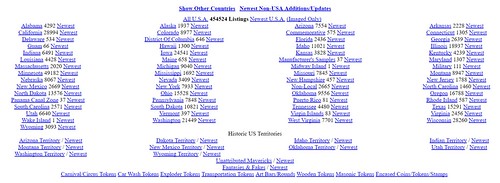
http://tokencatalog.com/

